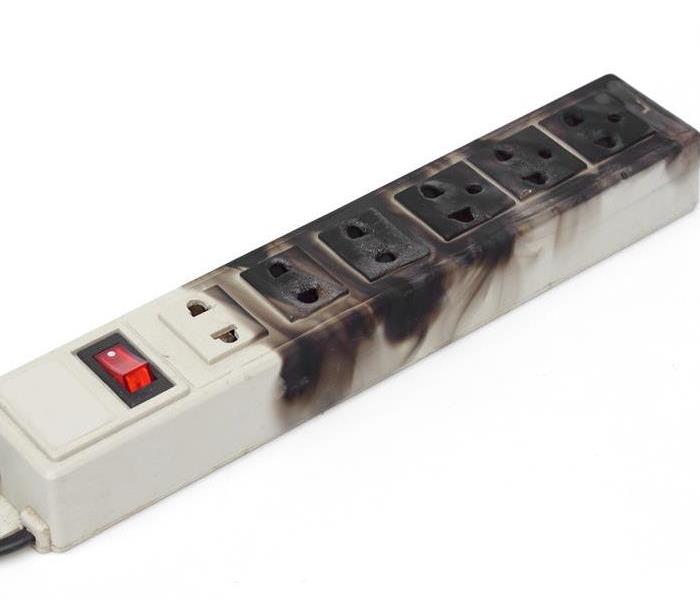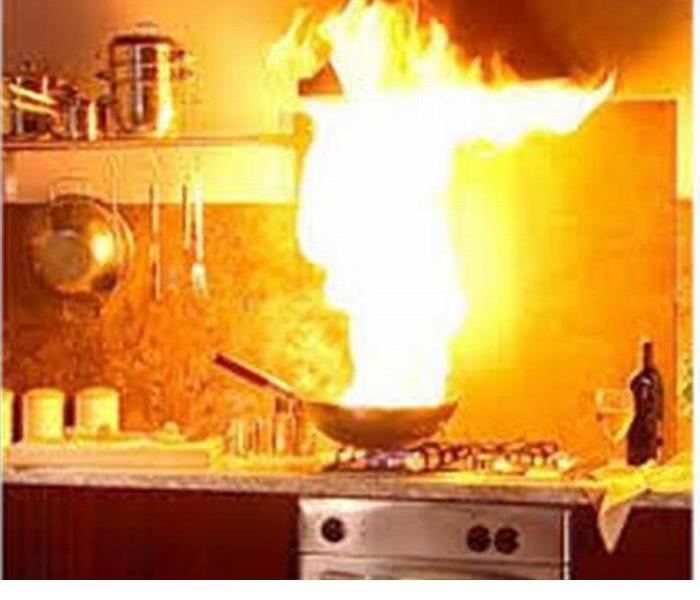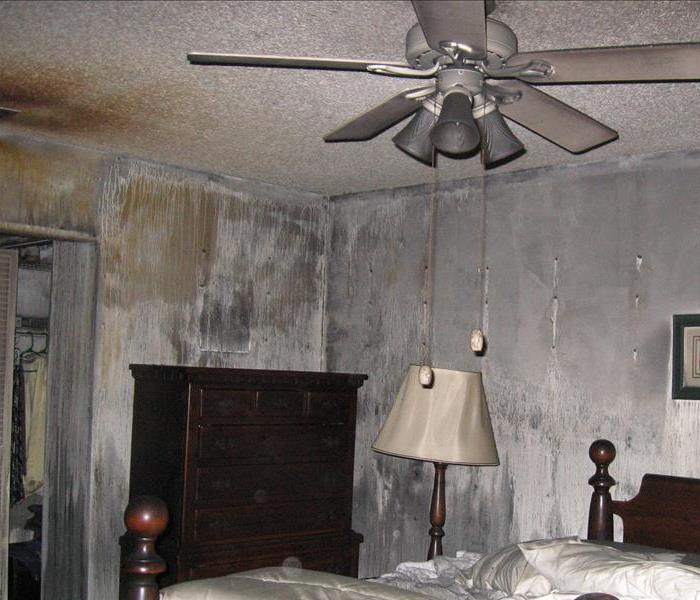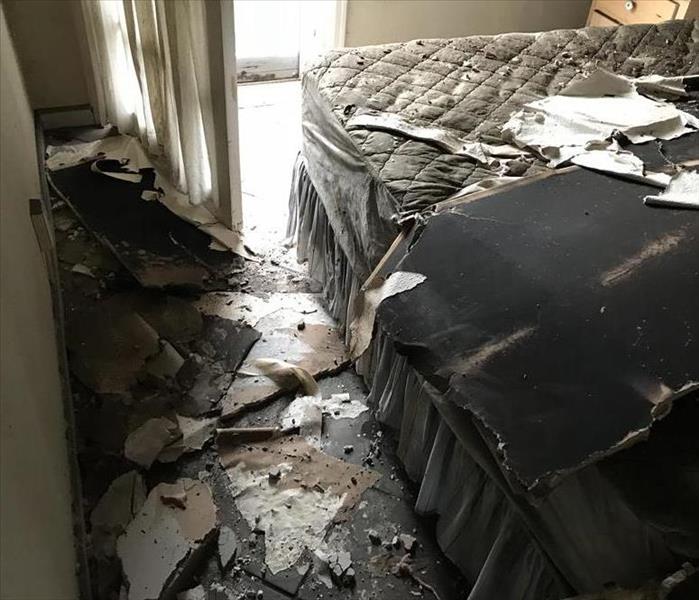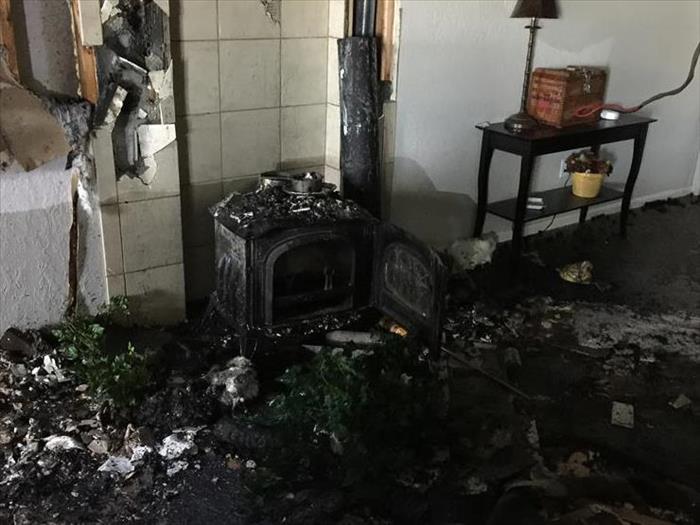Recent Fire Damage Posts
Teaching Your Family How to Escape a Home Fire
7/8/2022 (Permalink)
 It’s safer to crawl out during a building fire instead of standing upright.
It’s safer to crawl out during a building fire instead of standing upright.
Each year there are thousands of home fires; therefore, it’s wise to teach your family some fire safety tips. Your family's safety can be increased by teaching them the following ways to escape a home fire.
- Fire Crawl
Smoke and heat rise, so it’s best to crawl out during a fire instead of standing upright. Teach your family two fire crawl methods: the dog and snake. The dog crawl involves getting down on your forearms and knees and placing your nose on the ground like a dog sniffing. The snake crawl is best if it’s too hot to have your bottom in the air. - Bed Roll
Your family’s safety is your primary concern. Another method you should teach them is the bed roll. As the heat rises, the temperature of the area close to the ceiling can be more than a hundred degrees hotter than the space below. Instruct your family to turn to their side, reach their hand to the floor and gently roll off their bed without sitting up. - Door Check
Closed doors help stop a fire from spreading faster. However, when a door is opened during a fire, it can ignite a burst of firefrom the fresh supply of oxygen. Coach your family to feel the closed door with the back of their hand first. If it’s cool or only slightly warm, they can slowly open the door leading with their shoulder. If it’s hot, they should choose another way to escape. - Other Tips
Once your family understand the basic fireescape methods, it’s a good idea to discuss special circumstances. If they get trapped inside a room, teach them to go to a window to escape. If the room is not on the first floor, instruct them to yell for help and wave something so the firefighters know where they are. It’s also important to emphasize that once they get outside to stay outside.
Your family’s safety during a fire can be increased by teaching them how to escape. While you hope that your home never catches on fire, SERVPRO of Greeley/Windsor can assist you. Call us at 970-353-1388. We answer our phones 24/7/365 which puts our technicians onsite faster.
How To Prevent a Lint Fire in Your Dryer
7/8/2022 (Permalink)
 Avoid Fire Damage and Prevent a Lint Fire in Your Dryer by Following These Tips.
Avoid Fire Damage and Prevent a Lint Fire in Your Dryer by Following These Tips.
Lint in your dryer is not just a mere annoyance. It could also cause a lint fire that destroys your house That is why you should frequently clean the lint from your dryer. Removing the lint from the dryer screen is not enough. You also should do deep cleans of the vents and the interior. To keep your dryer functioning well and free of lint, all you need is:
- All-Purpose cleaner
- Vacuum
- Water
- Microfiber cloth
Prevent Dryer Fire by Eliminating Lint After Each Load
Whenever you finish running a dryer cycle, you should check the lint screen. Depending on the model you have, the screen could be on the side of the dryer, on the bottom of the door or at the top of appliance. You should be able to completely remove the screen by pulling it from the handle. Be careful not to pull too hard. If you bend the screen, you may not be able to get it back into the dryer.
After the screen is out of the dryer, use your hands or a brush to gather a small wad of lint. Rub this wad across the screen to attract additional lint. Then simply throw the lint into the garbage.
You may also want to rinse the lint screen with water every few weeks. Simply run the screen under the kitchen sink. You could additionally utilize soap if there is excess dust on the screen.
Before you put the screen back into the dryer, use your vacuum attachment to clean any lint that has accumulated in the vent. This should further keep your home safe from lint fire.
Deep Clean the Vents and Interior for Extra Fire Safety
Since a dryer fire can start in the interior sections of the appliance, you should deep clean these areas twice a year, as well. Unplug the machine and move it away from the wall. You should notice an exhaust hose. You can remove it by loosening the clamps with a screwdriver.
Next, take the hose to a well-lit area. Use a vacuum attachment or cleaning brush to remove any lint balls you see. You can then utilize a cleaning rod to eliminate lint from the vent in the wall.
After re-attaching the exhaust hose, you should also brush or vacuum the dryer vent on the outside of your home. Be sure to put the vent securely back in place. Otherwise, rodents or other pests could enter your home.
The entire interior of your dryer should be deep cleaned biannually, as well. Start by removing the back access panel. Wipe or vacuum any exposed sections, including the area around the exhaust vent. Just be careful when touching any of the wires near the vent. If you opt to clean the metal parts of the dryer, use a microfiber cloth. Once you are done, screw the panel back into place.
The above tips should keep your dryer functioning properly and reduce your chances of a lint fire. If your dryer or another appliance ever does cause fire damage to your home, emergency restoration professionals can assist you.
Our SERVPRO Professionals are highly trained in property restoration. From initial and ongoing training at SERVPRO's Corporate Training Facility to regular IICRC industry certifications, our Professionals are equipped with the knowledge to restore your property. The SERVPRO training program includes, but not limited to, the following:
- IICRC Training
- Employee Certification Training
- Initial Franchise Training
- e-Learnings
- Continuing Education Classes
For your fire damage needs call SERVPRO of Greeley/Windsor, 970-353-1388.
Choosing The Right Smoke Detector for Your Home
4/26/2022 (Permalink)
 Do your research when choosing the right smoke detector for your home or business.
Do your research when choosing the right smoke detector for your home or business.
Take The Following Considerations When Purchasing a Smoke Detector
We hope everyone knows the importance of smoke alarms. A working smoke detector increases the odds of you and your family escaping your, home during a fire. Alarms can also notify you of a small flame on the other side of your house. This may allow you to extinguish the blaze before it causes extensive harm that necessitates fire cleanup and restoration services.
However, choosing the right smoke alarm can sometimes be a challenge. You need reliable detectors that also fit your family's specific needs. Below are some factors to consider when picking your alarms.
- Type
There are two main types of smoke detectors.
- Ionization alarms detect quick-moving fires, such as those caused by paper or grease.
- Photoelectric alarms, meanwhile, are best at detecting slow fires from clothes or electricity.
Ideally, you should purchase both photoelectric and ionization alarms for your house. Since ionization detectors are more sensitive, you may want to keep them away from the kitchen. Otherwise, they could get triggered by smoke from cooking.
You can also install a system that connects all the detectors. This way, if one smoke alarm goes off, all of them will beep.
- Convenience
With your busy lifestyle, you do not want to spend excess time working on a smoke detector. Choose a model that is easy to maintain. If you opt for a battery-powered detector, pick one with drawers that make it easy to change the batteries. You may also want to find an alarm with a removable cover that simplifies the cleaning process. - Certification
Finally, pick a detector that has been testified and certified by a respected agency. Alarms that have an "FM " or "UL" label must meet certain standards.
You should take all the above considerations into account when picking each smoke alarm for your home. By choosing the right detectors and following basic fire safety rules, you can protect both your house and your loved ones.
If you do experience fire damage, call the professionals at SERVPRO of Greeley/Windsor, 970-353-1388. Our technicians and ready to respond to calls 24/7/365.
Controlling Odors Fire Damage Leaves Behind
2/21/2022 (Permalink)
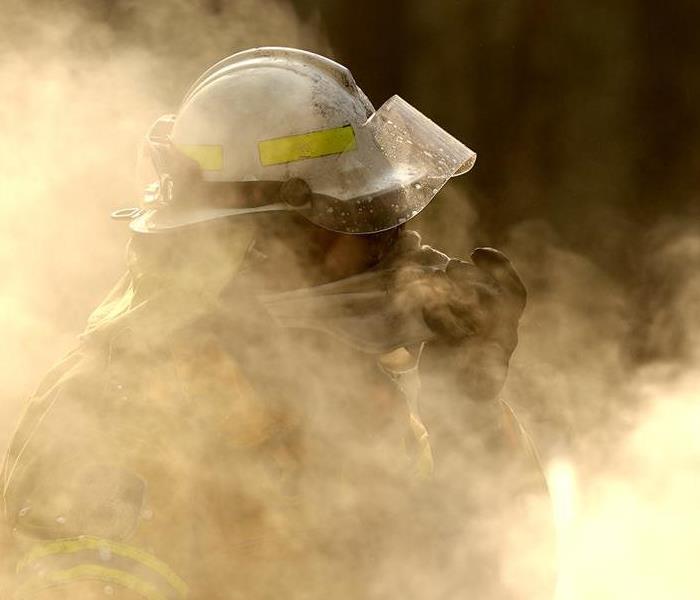 Experienced a fire/smoke loss? Call the professionals at SERVPRO of Greeley/Windsor.
Experienced a fire/smoke loss? Call the professionals at SERVPRO of Greeley/Windsor.
Odor-causing particles from the fire's smoke quickly end up in locations far from the fire's location. Because these areas do not contain fire damage, we do not need to remove anything from your home. However, hidden particles continue producing the smoky scent of the fire. SERVPRO the equipment to rid your home of this odor permanently.
If your home sustains fire damage, we can help you with your fire and smoke restoration needs, including odor elimination. Sprays and air fresheners only mask the smell without eliminating its cause. No matter where smoke particles hide, they disintegrate and break down, ending up in the air again. When you breathe them in, you smell them as smoke and burnt materials. Smoke is full of partially burned minuscule pieces of the things from within your home, and some of these may have carcinogenic properties. Smelling a smoky odor can become more than a minor inconvenience.
SERVPRO employees become certified by the IICRC in several different areas of restoration technology. Using this knowledge, our technicians use odor-neutralizing methods to remove these particles' ability to enter back into your home's air currents. Keeping them out of the air your family breathes keeps them from noticing these malodorous particles.
To remove hidden odor-producing smoke particles, we can implement thermal fogging. This method causes the physical bonding between chemical agents and unwanted particles from the fire. The powerful jets of steam penetrate the same locations the hot smoke went during the blaze. Bonding occurs quickly, providing our customers with the permanent elimination of problematic odors. This technique must be used cautiously to prevent the deterioration of vinyl, plastics, and rubber materials.
If used immediately after a fire, air scrubbers can make the air healthier for your family by significantly reducing the amount of soot in the air before it ends up deposited on surfaces or inhaled. While this does not eliminate all the soot, it can make things safer for more sensitive individuals, especially if they need to retrieve belongings. HEPA filters work well in conjunction with odor-eating activated charcoal filters. We work hard to improve the IAQ indoor air quality for our customers.
SERVPRO of Greeley/Windsor can help you control odors caused by fire damage and other disasters. We ensure that the families in our communities live in homes that pose no risk to the health of the occupants.
Locally Owned Company with National Resources
As a locally owned and operated business, SERVPRO of Greeley/Windsor is strategically located to respond quickly to your fire/smoke emergency. Call us today at 970-353-1388.
Practicing Safety While Using Your Home's Fireplace
2/9/2022 (Permalink)
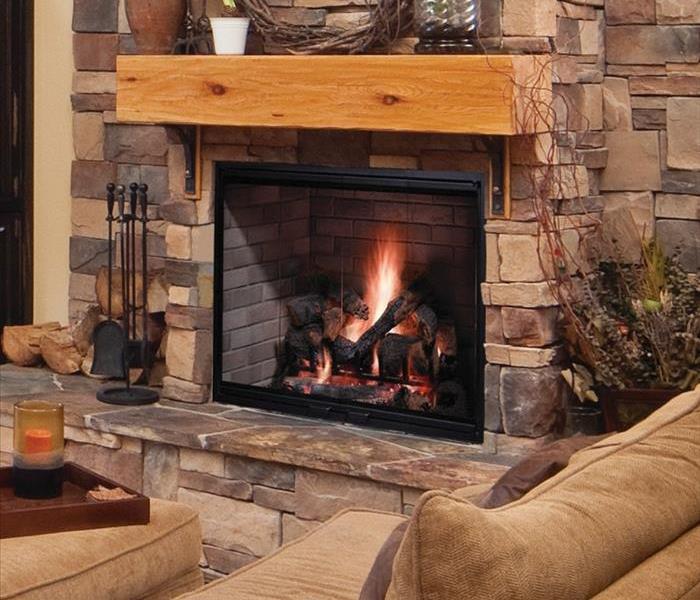 Fireplaces can be an added heat source for your home. Be sure you practice safety while using yours.
Fireplaces can be an added heat source for your home. Be sure you practice safety while using yours.
If your family enjoys spending an evening by the fire, you’re not alone. For many people, a wood-burning fireplace is an attractive feature for a family living room. They’re especially popular during the winter months when long nights at home make a warm fire especially appealing.
Wood-burning fireplaces can be very safe if they’re used the right way. Before you start a roaring fire at your home, take steps to be certain your fireplace and chimney are ready to warm your family safely.
Fireplace Safety Basics
Before you light your fire, ensure your chimney is capped and doesn’t have any cracks. You can get your home inspected and your chimney checked to be certain that it’s ready to be used.
Here are a few more things to do before you start your fire:
Consider cracking a window. Even though it’s probably cold outside, this step is to ensure your family is getting adequate clean air.
Add a screen. Fireplace screens are important to help protect your family and pets from the dangers that an open fire can represent.
Clean your fireplace. Don’t let ashes and debris gather. These can cause a fire hazard, if you light fire after fire on top of them.
Keep your fireplace clear. Not only is what is inside the fireplace important, what is around it matters, too. Keep your fireplace area clear from rugs, wood, paper, and other flammables.
Be prepared for the unexpected. Have a fire extinguisher handy. Also, be certain you have smoke alarms and a carbon monoxide detector installed in your home.
Our SERVPRO Professionals are highly trained in property restoration. From initial and ongoing training at SERVPRO's Corporate Training Facility to regular IICRC industry certifications, our Professionals are equipped with the knowledge to restore your property. The SERVPRO training program includes, but not limited to, the following:
- IICRC Training
- Employee Certification Training
- Initial Franchise Training
- e-Learnings
- Continuing Education Classes
For your fire/smoke restoration needs call SERVPRO of Greeley/Windsor, 970-353-1388.
Dos and Don'ts If You Experience a Fire Loss
1/20/2022 (Permalink)
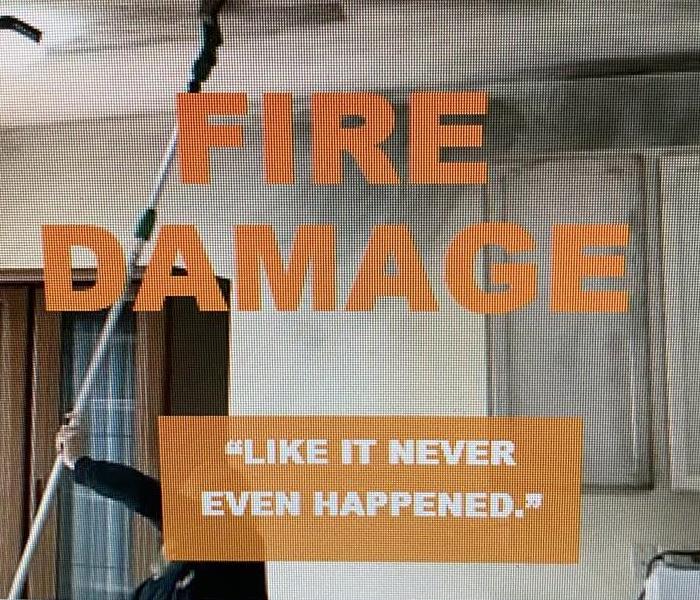 Call SERVPRO of Greeley/Windsor if you experience a fire loss.
Call SERVPRO of Greeley/Windsor if you experience a fire loss.
A fire can be devastating to your home or business. After the fire trucks leave, your property can suffer from not only fire and smoke damage, but also widespread water damage and flooding from firefighting efforts. SERVPRO of Greeley/Windsor has specialized fire and water damage restoration training and experience to quickly clean up and restore your home. Additionally, we can remove the pervasive smoke odor and deep-clean soot from upholstery and carpet.
What to do after a fire:
- Keep hands clean so as not to further soil upholstery, walls, and woodwork.
- Place clean towels or old linens on rugs, upholstery, and carpet traffic areas.
- If electricity is off, empty freezer and refrigerator and prop doors open.
- Clean and protect chrome with light coating of petroleum jelly or oil.
- Wash houseplants on both sides of leaves.
What NOT to do after a fire:
- Do not attempt to wash any walls or painted surfaces or shampoo carpet or upholstery without contacting SERVPRO of Greeley/Windsor.
- Do not attempt to clean any electrical appliances that may have been close to fire, heat, or water without consulting an authorized repair service.
- Do not use any canned or packaged food or beverages that may have been stored near the fire, heat, or water.
- Do not turn on ceiling fixtures if ceiling is wet. The wiring may be damaged.
- Do not send garments to an ordinary dry cleaner. Improper cleaning may damage garment further.
Board-ups
Firefighters may break windows and/or cut holes in the roof to vent the fire. It is extremely important to secure openings to your structure using sturdy, durable materials designed to protect it from both weather intrusion and intrusion by outsiders.
Types of Fire/Smoke/Soot
- Wet Smoke – Plastics and Synthetics; Low heat, smoldering, pungent odor, sticky, smeary.
- Dry Smoke – Paper and Wood; Fast burning, high temperatures, dry, powdery, non-smeary residues.
- Protein – Invisible, discolors paints and varnishes, extreme pungent odor.
- Fuel Oil Soot – Furnace Puff Backs. Other Types – Tear gas, fingerprint powder and fire extinguisher residue.
SERVPRO of Greeley/Windsor has what it takes to restore your home back to preloss condition. If you experience a fire loss call SERVPRO of Greeley/Windsor at 970-353-1388, we answer our phones 24/7/365, which puts our technicians onsite faster.
Smoke Alarm 101: Knowing When to Change the Batteries
10/6/2021 (Permalink)
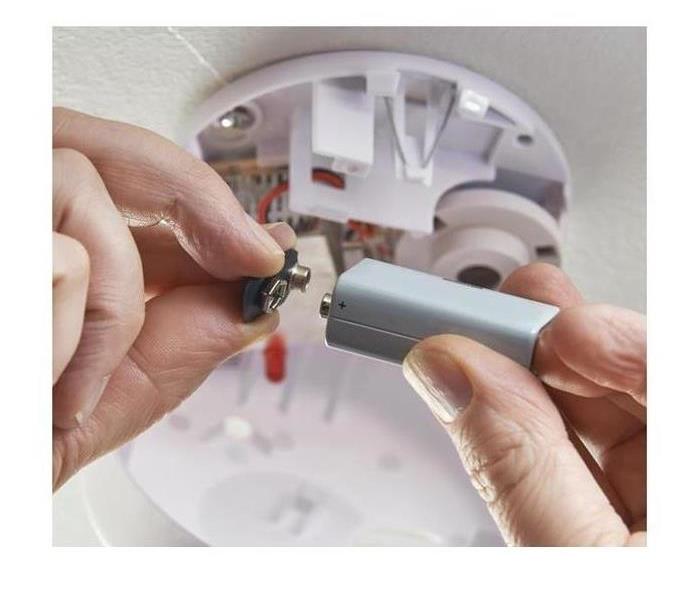 Make sure to change your smoke alarm batteries every Fall when you set your clocks back
Make sure to change your smoke alarm batteries every Fall when you set your clocks back
Smoke alarms are among the most common ways to prevent home fires. But these potential saviors are only useful if they’re working – and too often they aren’t. The top reason is dead batteries. When should you replace the batteries in your home fire alarms? Here are a couple of pointers to guide you on handling the alarms in your home.
About Fire Alarms
Public awareness efforts have transformed smoke detectors and fire alarms into one of the most common prevention tools in the average home. They’re easy to use and effective against stopping fire damage or worse. But for every one that is functioning, there are others that aren’t. As a result:
- Home fire deaths happen most often when there are no alarms or non-working
- Of fires in homes with alarms that failed, about half were due to missing batteries
Know Your Battery
Today’s smoke alarms often are powered by lithium batteries or 9-volt batteries. A lithium-powered alarm won’t need a new battery for a decade. But a 9-volt needs annual replacing. Do it when you set your clocks back and you won’t forget.
Don’t Ignore the Beep
Most homeowners are familiar with the annoyance of a falsely beeping fire alarm. Don’t ignore the sound. A beeping alarm is a sign your alarm is running low on juice. So, heed the beep and replace the battery.
Know Expiration Dates
The average smoke detector will function properly for eight to 10 years. After that, you’ll need to replace it. Keep a log of the age of your device. You should also look at your device manual to determine if your alarm needs more frequent replacement.
Smoke alarms have drastically reduced the impact of house fires. But they must be used properly to protect your home. Change your alarm batteries on time, every time and minimize the risk of damage and expensive fire cleanup in your home.
Unexpected Fire Hazards in Your Home
8/30/2021 (Permalink)
 If you experience a fire, call SERVPRO of Greeley/Windsor at 970-353-1388
If you experience a fire, call SERVPRO of Greeley/Windsor at 970-353-1388
Some of the most dangerous fire hazards in your home are completely unexpected and are things you might not think about every day. Not all fire hazards are so predictable like leaving a candle unattended or smoking inside your house. The lesser-known fire hazards are just as troubling than most common ones because you do not see them coming until it is too late.
Here are some unexpected fire hazards in your home that you should pay attention to:
- Dryer lint – Excessive heat and lint buildup is just asking for trouble. It is important to clean the dryer vent and exhaust duct regularly.
- Dust – Dust can be a fire hazard if it collects near floor heaters, electronics and sockets. If sparks fly, dust piles can ignite and start a house fire. Be sure to look under appliances and remove dust buildup.
- Gas water heater – Clothes piled too close to a gas water heater can ignite when the water heater comes on.
- Laptops – Laptops running for long periods of time tend to get fairly-hot. A hot laptop that is left on a bed, couch, blanket or other soft surfaces can prevent air flow in and out of the cooling vents. This can produce enough heat to ignite and start a fire.
- Crumbs in the toaster – Have you checked your toaster crumbs recently? As crumbs pile up on the bottom, a spark can easily catch fire and start a flame that catches on to items surrounding the toaster.
- Leaves in gutters – Allowing leaves to gather up in your gutters or bushes to over grow can cause a major fire risk. Be sure to clean your gutters and your lawn regularly to reduce the risk of a fire.
An unexpected fire is devastating and can destroy your home along with your personal belongs. Be proactive in protecting your home from a fire hazard. Be alert and check your house routinely. If the unimaginable ever does happen, SERVPRO of Greeley/Windsor will make it “Like it never even happened.” Call us at 970-353-1388, we answer our phones 24/7/365 which puts our professional technicians onsite quicker.
Structure Fire Smoke and Wildfire Smoke – What Is The Difference?
8/11/2021 (Permalink)
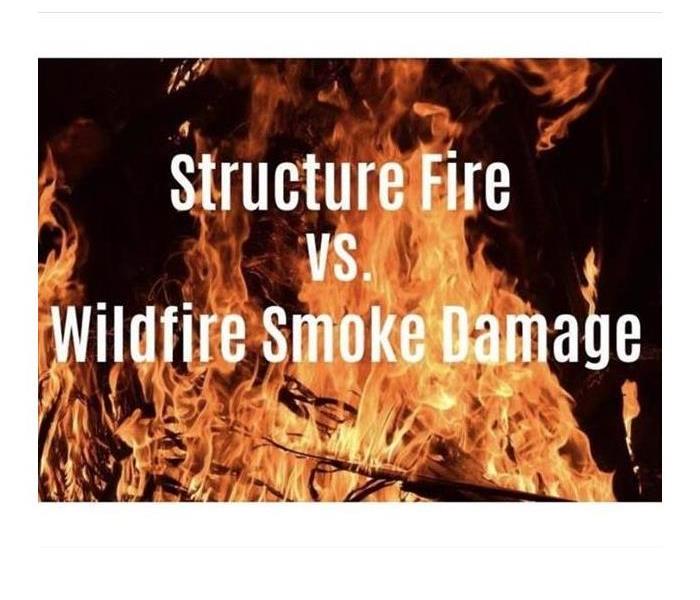 Structure Fire vs. Wildfire Smoke Damage
Structure Fire vs. Wildfire Smoke Damage
No debate needing, inhaling smoke from any type of fire can be hazardous to your health.
As restoration contractors, we usually aren’t faced with that immediate, thick smoke, but dangers still remain after the fire is out – whether it’s dealing with structural damage from a large house fire, or smoke odor removal following a wildfire.
House Fire Smoke
There are more than one million house fires in the U.S. each year, meaning there are a lot of fire jobs out there for restoration companies. The biggest dangers post-fire come from VOCs (volatile organic compounds) found in the air that have been released from contents within the structure. For example, when some materials burn – like synthetic rubber, plastic, or foam – they can release cyanide into the air. Those substances are commonly found in furniture, clothing, Tupperware, and so much more within any structure.
Research published by the National Institutes of Health back in 2002 said, “During the past 50 years, synthetic polymers have been introduced in buildings in very large quantities. Many contain nitrogen or halogens, resulting in the release of hydrogen cyanide and inorganic acids in fire smoke as additional threats.”
Exposure to these VOCs is why proper PPE is critical during fire jobs, especially during the initially scoping, estimating, and demo phase if the fire was severe.
Wildfire Smoke
Wildfire smoke also carries fine particles that can be dangerous. These particles tend to come from more organic sources, versus the synthetic sources we talked about above from house fires. When thinking about wildfire smoke, think about burning trees and other plant materials, and just how dense the air can get when the fire is nearby. Add to that litter, synthetic compounds from local structures that have burned, and ash, and it’s a recipe for disaster – even after the fire.
When remediating a structure affected by wildfire smoke, it is important to remember to clean air ducts as well because it’s likely even the most inner parts of the structure have been touched by the smoke and soot.
Protection during Fire Damage Remediation
Here are some quick tips to keep your team safe during fire jobs, no matter the cause or source of the fire.
- Wear proper PPE. This includes respirators (make sure a proper fit test has been completed). A dust mask is not enough.
- Avoid direct contact with anything directly affected by the fire. This is why PPE is critical. If you handle affected items with bare hands, it is easy for contaminants to transfer into your body.
- Use equipment, like HEPA vacs, that filter out small particles.
- Ventilate the area where you are working if possible. If the smoke damage has not affected the HVAC system, turning that system on before remediating the smoke damage and odor could cause the odor and soot to be circulated throughout an entire building instead of contained to a certain area.
- Consider having IAQ (Indoor Air Quality) testing done to determine VOCs in the air and establish a scope of work and remediation protocol.
4 Steps for Using a Fire Extinguisher Correctly
7/12/2021 (Permalink)
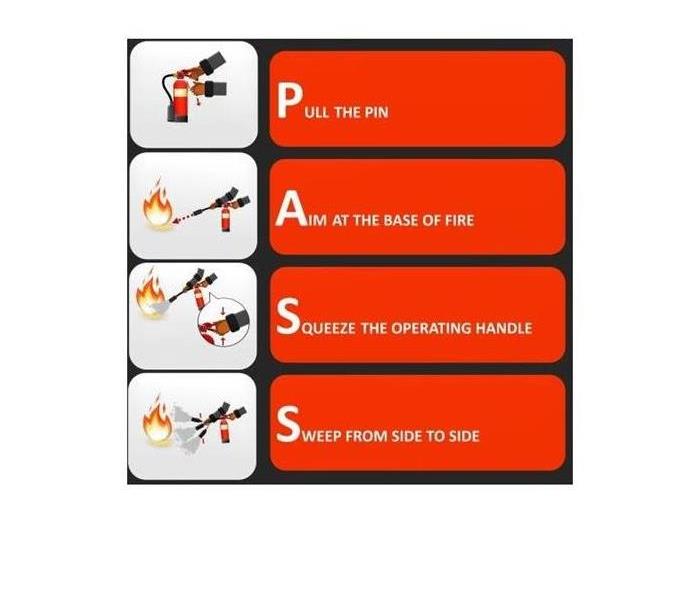 For use of a fire extinguisher memorize the P.A.S.S. method.
For use of a fire extinguisher memorize the P.A.S.S. method.
P.A.S.S. Method
Your commercial building in Greeley, CO must be equipped with enough fire extinguishers that anyone who needs to do so can reach one quickly in an emergency. It does not do a lot of good to have a fire extinguisher nearby, however, if your employees don't know how to use it properly. Every person in your building needs to understand the four basic steps of the P.A.S.S. method.
- Pull
Every canister is equipped with a safety feature that keeps it from releasing its contents spontaneously. There is a seal and a pin that holds it in place. Before you can use the extinguisher, you must pull the pin out and break the seal.
- Aim
You may notice that your extinguisher comes equipped with a hose. If you aim the hose at the top of the flames, however, you will not get the coverage you need. To prevent extensive fire damage that requires professional restoration services, you must aim the hose at the base of the fire.
- Squeeze
The fire extinguisher has a handle that allows you to release the contents of the canister. To do so, you must squeeze the handle so that the extinguishing agent comes out the end of the hose, allowing you to direct it at the base of the fire.
- Sweep
If you have a small kitchen fire in your break room, you can probably put it out with the contents of the extinguisher. To do so, you need to make sure the entire base of the fire is covered in the agent that is released. Make a sweeping motion back and forth until the fire goes out or you run out of agent.
If the contents of a fire extinguisher do not put the fire out, do not grab another extinguisher. Call the fire department so that the professionals can take over. In many cases, however, using an extinguisher correctly will put out the fire and prevent a larger problem.
The sooner SERVPRO of Greeley/Windsor’s experienced and trained team can get on-site and begin the fire mitigation process, the better; not only for you, but for the building and contents as well. Give SERVPRO® of Greeley/Windsor a call at (970) 353-1388. We will make it “Like it never even happened.”
The Basics of Smoke Odor Removal
7/12/2021 (Permalink)
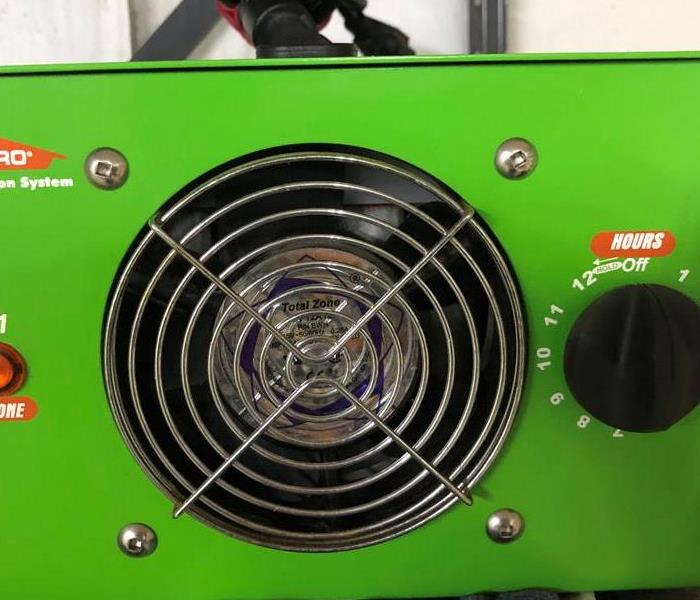 Ozone Machine - Air filtration equipment eliminates the fine particles and chemicals introduced by smoke.
Ozone Machine - Air filtration equipment eliminates the fine particles and chemicals introduced by smoke.
After a fire has blazed through your property, you have several aftereffects to deal with besides destruction from the flames themselves. Smoke damage also remains, leaving its telltale smell along with chemical pollution and possible structural issues. For these reasons, smoke cleaning in the Greeley/Windsor area becomes an essential component of a restoration company’s techniques when they work to bring your property back to normal after a fire.
The Right Equipment for the Job
Restoration professionals have many tools at their disposal to permanently eradicate smoke odor from your property. In their arsenals, you will typically find three types of smoke cleaning equipment:
• Air filtration devices
• Thermal foggers
• Ozone machines
Air filtration equipment eliminates the fine particles and chemicals introduced by smoke. Moreover, thermal foggers put out millions of ultra-fine droplets that are each roughly the same size as the smoke particles still residing inside your building, delivering odor counteractants to wipe out the smoke’s chemical composition and dissipate the smell.
A Word About Ozone Machines
You have probably seen ozone machines available on the consumer market during the last couple of decades, but restoration companies use professional-grade devices instead. The O3 that they produce consists of molecules bearing three oxygen atoms instead of the standard paired oxygen atoms that exist in standard breathable Earth air. This deployed ozone works by bonding itself to chemicals at the molecular level, changing their composition and nullifying both their odors and harmful effects. However, commercial-grade equipment is meant to achieve immediate results in the hands of experts, and you should not attempt to use ozone devices on your own due to the potential hazards involved.
Leave Smoke Odor Remediation to the Experts
Fire restoration is a dedicated methodology using complex techniques and innovative technology. When utilized properly by odor removal technicians, each type of equipment eliminates the harmful chemicals and noxious odors left behind by smoke. In the hands of experts, these devices working together achieve high-quality smoke cleaning for your premises.
For more information, visit http://www.SERVPROgreeleywindsor.com/fire-smoke-damage-restoration or call SERVPRO of Greeley/Windsor at 970-353-1388.
Is Hoarding a Fire Hazard
4/13/2021 (Permalink)
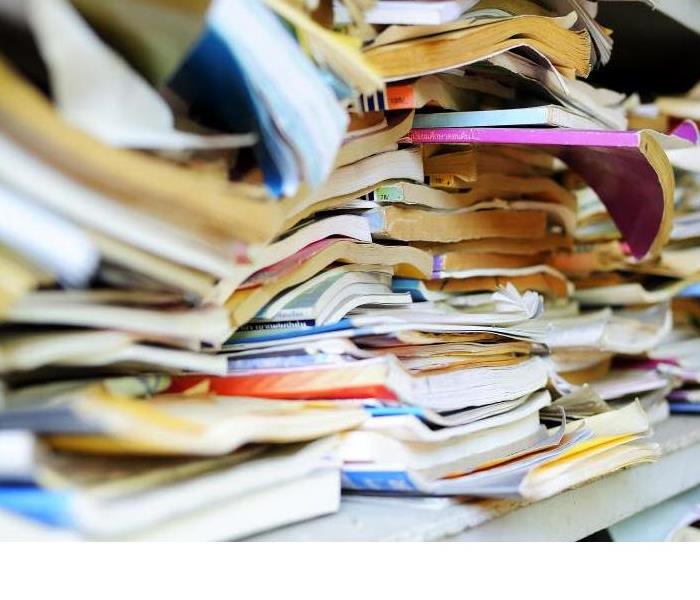 Clutter caused by hoarding can be a fire hazard in a home.
Clutter caused by hoarding can be a fire hazard in a home.
Do you have a person in your life who may be a hoarder? According to the National Fire Protection Association (NFPA) fires are bigger and costlier than typical residential fires https://www.nfpa.org/News-and-Research/Publications-and-media/NFPA-Journal/2012/January-February-2012/Features/The-Dangers-of-Too-Much-Stuff/Bigger-and-Costlier. Hoarding is a condition where a person has persistent difficulty discarding personal possessions. The large amount of possessions fill the home and prevent the normal use of the space. Living space becomes cluttered making it unusable as the space was designed. Hoarding can lead to fire hazards in the home.
Why Hoarding Increases Fire Risks:
- Cooking is unsafe if flammable items are close to the stove or oven.
- Heating units may be too close to things that can burn. They might also be placed on dangerous, unstable surfaces. If a heater tips over into a pile, it can cause a fire.
- Open flames from smoking materials or candles in a home with excess clutter are very dangerous.
- Blocked pathways and exits may hinder escape from a fire.
How Hoarding Impacts First Responders:
- Hoarding puts first responders in harm’s way.
- Firefighters cannot move swiftly through a home filled with clutter.
- Responders can be trapped in a home when exits are blocked. They can be injured by objects falling from piles.
- The weight of the stored items, especially if water is added to put out a fire, can lead to building collapse.
- Fighting fires is very risky in a hoarding home. It is hard to enter the home to provide medical care. The clutter impedes the search and rescue of people and pets.
SERVPRO of Greeley/Windsor has experience with cleaning hoarding homes. If a family member is struggling and you need assistance, please call our office at (970) 353-1388. We answer our phones 24/7/365, and would be happy to assist you in making your home a safe place.
The 3 P's of Fire Safety
2/12/2021 (Permalink)
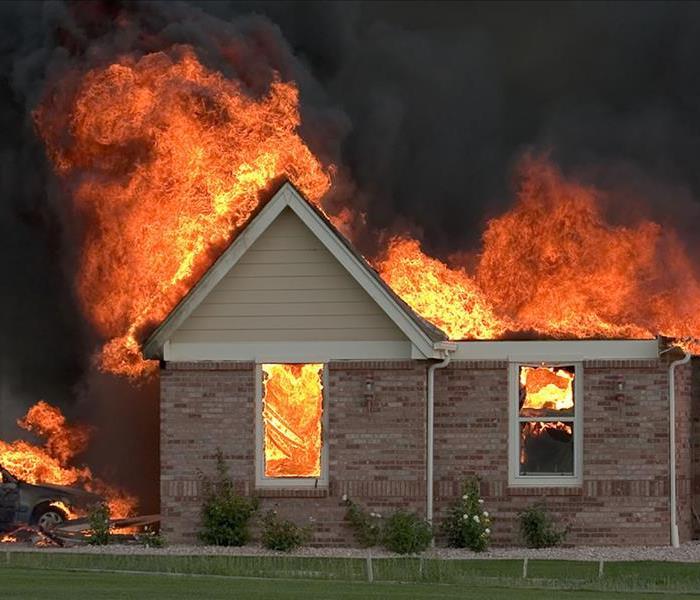 If you experience fire damage, call SERVPRO of Greeley/Windsor
If you experience fire damage, call SERVPRO of Greeley/Windsor
One of the best ways to protect your kids safety from a Greeley area home fire is to teach them about fire prevention. As part of your efforts, cover basics such as these three Ps of safety:
Prepare – This step focuses on reducing the risk of fire damage situations
Prevent – This step includes teaching your children about getting out safely
Practice – This final step covers conducting fire drills and overall fire safety habits
You should also include a fire escape plan in these efforts.
Prepare Your Home
There are several situations that are common to just about any home, and many of these could easily lead to fire damage, such as overloading electrical outlets, leaving lit candles unattended, setting clutter near a hot stove, neglecting old and damaged wiring, and using old appliances. When you involve your children in this first step of fire prevention, the whole family is safer.
Prevent Injuries During Fire
This part of the plan should include discussions about not playing with matches or lighters but telling an adult about them if they find them laying around. Teach your children the Stop, Drop, Roll technique in the event their clothing is on fire. Talk about never going back into a building that is on fire. Teach children that fire damage cleanup is not their responsibility.
There are many resources available for kids safety practices and fire prevention habits. If you talk with fire and smoke damage restoration professionals about fire cleanup, ask them for further advice. Consistently review the three Ps of fire safety to protect your family from harm.
Practice Fire Escape Plans
Establish a fire escape plan and for your kids safety and run drills regularly. These drills should include what to do if the primary escape route is blocked. During these drills, watch out for things such as clutter in the hall. Take time to practice how children should escape if their doorknob is hot, signaling to them that it is not safe to open their bedroom door. Discuss the importance of remaining low to the ground, so they do not inhale smoke while exiting.
SERVPRO of Greeley/Windsor is standing by 24/7/365 to help you deal with fire damage and our professionals are ready to help clean and restore your home “Like it never even happened.”
If you do experience fire damage, SERVPRO of Greeley/Windsor is available 24 hours a day, 7 days a week, 365 days a year. Call 970-353-1388.
Top 5 Most Common Causes of House Fires
2/1/2021 (Permalink)
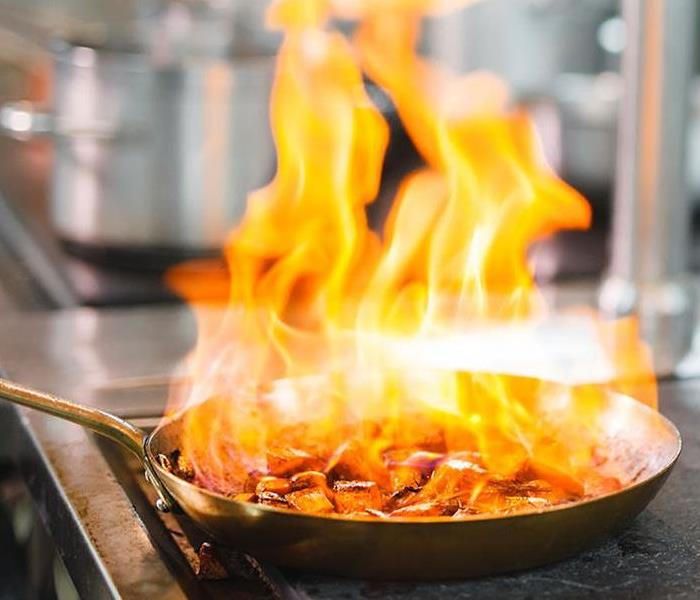 The top 5 most common causes of house fires as identified by the National Fire Protection Association
The top 5 most common causes of house fires as identified by the National Fire Protection Association
- Candles
From 2007-2011, the NFPA says there were an average of 10,630 fires in the U.S. that were started by candles, causing 115 deaths, 903 injuries and approximately $418 million in property damage. That is an average of 29 candle fires per day.
Safety tips:
- Never leave a candle burning near flammable items.
- Never leave a candle burning in a child’s room or an unoccupied room.
- Make sure candles fit securing into candle holders so they will not tip over.
- Blow out any candles before leaving a room or going to sleep.
- Smoking
While the number of fires caused by smoking is trending downward, the NFPA found that there was still an average of 17,600 related fires per year resulting in 490 deaths and more than $516 million in property damage.
Safety tips:
- If you smoke, consider smoking outside.
- Use wide, sturdy ashtrays to catch butts and ashes.
- Look for cigarette butts under furniture and between seat cushions to make sure no lit butts have fallen someplace where they cannot be seen.
- Do not smoke in bed, when you are tired or around medical oxygen.
- Electrical & Lighting
According to the NFPA, in 2011 approximately 47,700 home structure fires were caused by some sort of electrical failure or malfunction. These resulted in 418 deaths, 1,570 injuries and $1.4 billion in property damage.
Safety tips:
- Do not overload outlets or electrical cords.
- Make sure you have the right cord for the job – inside cords for inside, heavy duty/outside cords for outdoor use.
- Do not leave Christmas lights, Christmas trees, or halogen lights on overnight or when not at home.
- Consider having an electrician perform an annual checkup of your home’s wiring.
- Dryers & Washing Machines
Clothes dryer fires happen more often than one might think, accounting for 16,800 home structure fires in 2010 and doing more than $236 million in property damage.
Safety tips:
- Clean the lint screen frequently and do not run the dryer without it.
- For gas and propane dryers, make sure there are not any leaks in the lines.
- Vent the dryer to the outside of the house and ensure nothing blocks the vent pipe.
- Clean the vent pipe and the area where the screen is housed.
- Keep the area around the dryer free of combustible materials.
- Lightning
From 2007-2011, NFPA says there were an average of 22,600 fires per year caused by lightning strikes.
Safety tips:
- Stay away from doors and windows during an electrical storm.
- Do not use corded phones, computers, TVs or other electrical equipment during storms.
- Unplug major electronics – TVs, stereo equipment, computers, and microwaves to minimize damage if there is a lightning strike close by.
- Avoid plumbing such as sinks, baths and faucets during a thunderstorm.
You experience a fire in your home call SERVPRO of Greeley/Windsor, 970-353-1388. No answering service, we answer our phones 24/7/365.
Microwave Oven Safety
1/29/2021 (Permalink)
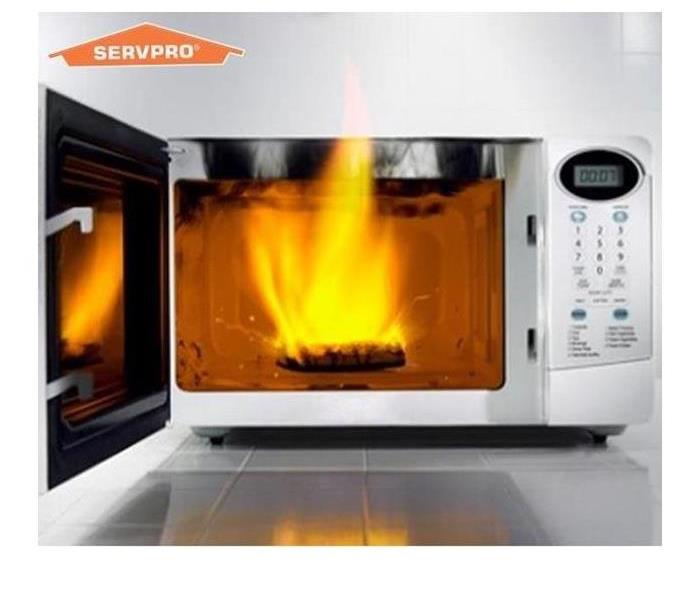 Call SERVPRO of Greeley Windsor if you experience fire/smoke damage in your home.
Call SERVPRO of Greeley Windsor if you experience fire/smoke damage in your home.
We have all thought about the left-over pizza in our refrigerators and cannot wait to get home to reheat it in a microwave oven. These appliances are great to reheat and enjoy leftovers and other snacks without the hassle of actually cooking them. But, did you know that there are potential hazards to microwaves?
When not maintained properly, microwaves ovens can become extremely hazardous. According to the National Fire Protection Association (NFPA), 1 in 6 of microwave ovens cause home fires every year. Once a fire is ignited in the microwave, it can quickly catch the whole appliance on fire. This can lead to the fire spreading to other areas of your kitchen and potentially your whole house. These fires can cause an annual average of 10 deaths, 150 injuries, and around $31 million in property damage.
To prevent potential, follow these tips below:
- Purchase a microwave oven that is listed by a qualified testing laboratory. Make sure to complete and return the product registration card. This way the manufacturer can reach you if there is a recall on the product.
- Make sure children are supervised when using microwaves.
- Plug the microwave oven directly into the wall outlet – never use an extension cord.
- Make sure the microwave oven is at a safe height, within easy reach of all users.
- Open food slowly, away from the face. Hot steam or the food itself can cause burns.
- Food heats unevenly in microwave ovens. Stir and test before eating or giving to children.
- Never heat a baby bottle in the microwave.
- Clean regularly.
If a fire happens to break out, follow these steps:
- Leave the door to the microwave closed.
- Turn the microwave off and unplug it from the wall.
- Call the fire department immediately.
Home fires happen unexpectedly and are can sometimes be out of control. Remember if your home suffers from fire damage, SERVPRO of Greeley/Windsor will be ready to help and make it “Like it never even happened.” Our professionals at SERVPRO of Greeley/Windsor rapidly respond 24/7, and you can reach us at (970) 353-1388.
Thanksgiving Day Safety Tips
11/18/2020 (Permalink)
 Do not let this happen to you on Thanksgiving Day!
Do not let this happen to you on Thanksgiving Day!
Did you know that Thanksgiving is the peak day for home cooking fires, followed by Christmas, and Christmas Eve? We want you to enjoy these days with your loved ones, so here are a few safety tips for when you are cooking that scrumptious meal.
- Stay in the kitchen when you are cooking on the stovetop so you can keep an eye on the food.
- Stay in the home when cooking your turkey and check on it frequently.
- Keep children away from the stove. The stove will be hot and kids should stay 3 feet away.
- Make sure kids stay away from hot food and liquids. The steam or splash from vegetables, gravy or coffee could cause serious burns.
- Keep the floor clear and clean so you don’t trip over kids or toys or slip on a slick floor.
- Keep knives out of the reach of children.
- Be sure electric cords from an electric knife, coffee maker, plate warmer or mixer are not dangling off the counter within easy reach of a child.
- Keep matches and utility lighters out of the reach of children — up high in a locked cabinet.
- Never leave children alone in room with a lit candle.
- Make sure your smoke alarms are working. Test them by pushing the test button.
- Be especially aware when Deep Frying a turkey, people tend to put too much oil in which causes overflow and spreads to the open flame causing a mass fireball. Also putting in a frozen or very wet bird can cause major problems which they call B.L.E.V.E which stands for Boiling Liquid Expanding Vapor Explosion.
- Always use fryer outside away from any structure
- Keep oil under 350 degrees, the hotter the oil the more combustible it is
- Don’t overfill the pot with oil
- Thoroughly defrost turkey (24 hours for every 10 pounds the turkey weighs)
- Turn off flame before putting turkey in
- Keep grease fire approved extinguisher on hand
- Lower turkey into pot slowly
- If by unfortunate event you have an emergency this Holiday Season please know your SERVPRO of Greeley/Windsor is available 24 hours a day, 7 days a week, 365 days a year. Contact us at 970-353-1388 and our technicians will be onsite with 4 hours of receiving your call.
From our SERVPRO to your family, Happy Thanksgiving!
Fire Extinguisher Use Techniques
10/1/2020 (Permalink)
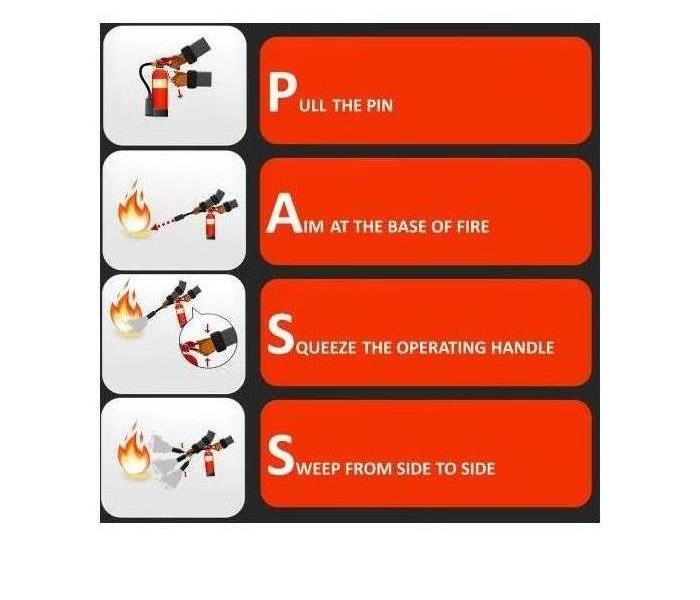 Know the Proper Way To Use A Fire Extingusher
Know the Proper Way To Use A Fire Extingusher
Do your employees know the techniques of fire extinguishers? A fire extinguisher is one of the most essential pieces of life-saving equipment in your commercial property. While your fire suppression system is excellent for your overall facility and alarms will ensure the safe evacuation of your employees or tenants, extinguishers provide a direct line of defense and allow for immediate response to manageable fires. There is a four-step process known as the P.A.S.S. technique.
- Pull-The first step is to pull the pin from the extinguisher handle. The removal of this pin will allow the handle to be fully compressed, releasing the compressed air and chemical mixture to extinguish the flames.
- Aim- A fire extinguisher will typically have a short, flexible, rubber hose attached to the nozzle and extending away from the handle. This will allow you to aim the compressed mixture at the fire. However, be sure to avoid contact with the discharge opening as the CO2 can damage your skin.
- Squeeze- Squeezing the handle will release the extinguishing agent. Its mixture will come out quickly and somewhat powerfully, so be prepared and keep firm aim on the blaze.
- Sweep- While focusing on the extinguishing mixture at the base of the fire, you will want to use a slow sweeping motion. After the fire is out, watch the area and ensure that there are no remaining embers. It is possible for a fire to reignite, causing more fire damage.
Keep everyone in your workplace safe with the knowledge of proper procedures of fire extinguishers. If you have any questions regarding the proper technique, you can contact your local fire department for help.
If you have suffered business or home fire damage, call SERVPRO of Greeley/Windsor at 970-353-1388.
Fire Smoke Cleanup
8/28/2020 (Permalink)
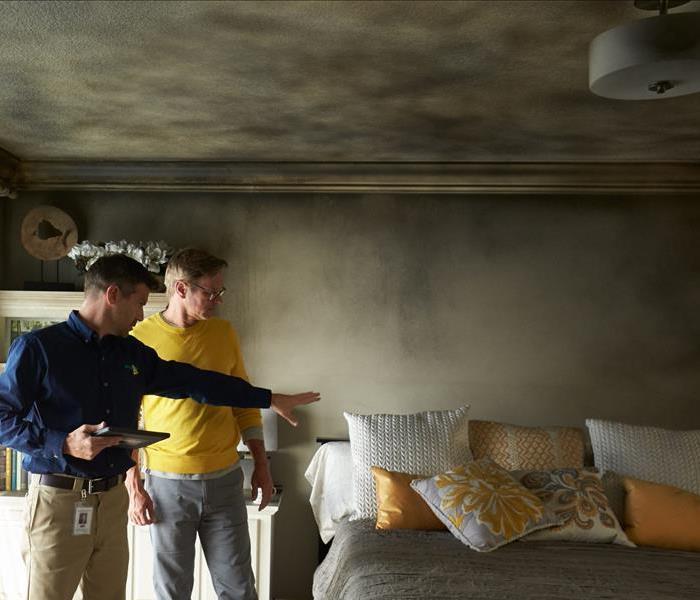 When you have fire, smoke, or soot damage, rely on the professionals at SERVPRO of Greeley/Windsor to assist with the cleanup.
When you have fire, smoke, or soot damage, rely on the professionals at SERVPRO of Greeley/Windsor to assist with the cleanup.
Smoke and soot are very invasive and can penetrate various cavities within your home, causing hidden damage and odor. Our smoke damage expertise and experience allow us to inspect and accurately assess the extent of the damage to develop a comprehensive plan of action.
Smoke and soot facts:
Hot smoke migrates to cooler areas and upper levels of a structure.
- Smoke flows around plumbing systems, seeping through the holes used by pipes to go from floor to floor.
- The type of smoke may greatly affect the restoration process.
Different Types of Smoke
There are two different types of smoke–wet and dry. As a result, there are different types of soot residue after a fire. The cleaning procedures will then be based on the information identified during pretesting. Here is some additional information:
Wet Smoke – Plastic and Rubber
Low heat, smoldering, pungent odor, sticky, smeary. Smoke webs are more difficult to clean.
Dry Smoke – Paper and Wood
Fast burning, high temperatures, heat rises therefore smoke rises.
Protein Fire Residue – Produced by evaporation of material rather than from a fire
Virtually invisible, discolors paints and varnishes, extreme pungent odor.
Our Fire Damage Restoration Services
Since each smoke and fire damage situation is a little different, each one requires a unique solution tailored for the specific conditions. We have the equipment, expertise, and experience to restore your fire and smoke damage. We will also treat your family with empathy and respect and your property with care.
Have questions about Fire, Smoke, or Soot Damage? Call SERVPRO of Greeley/Windsor, 970-353-1388
Wildfire Prevention Tips For The Rocky Mountains
8/27/2020 (Permalink)
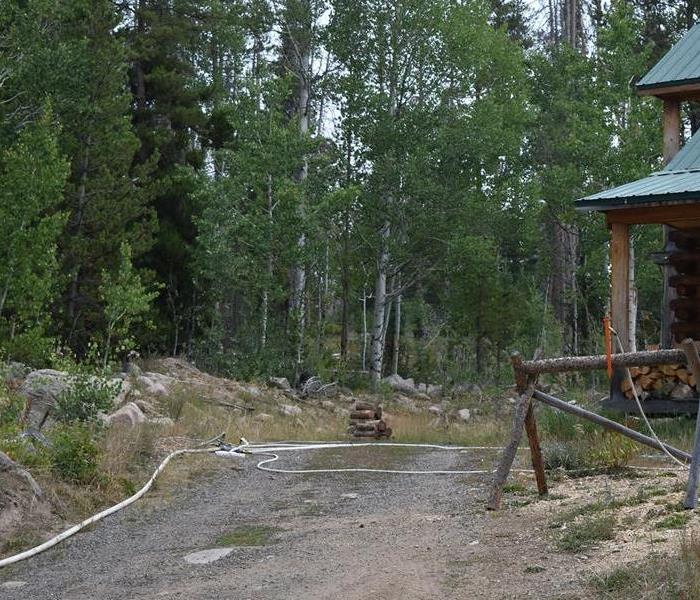 Call SERVPRO of Greeley/Windsor for your fire and smoke Remediation
Call SERVPRO of Greeley/Windsor for your fire and smoke Remediation
Taking proactive measures to mitigate wildfire damage is a good idea year around. SERVPRO® of Greeley/Windsor wants to help the people to prevent wildfires from harming their vacation home, residence and/or commercial property. Here are some of the tips that are offered by the Colorado State Forest Service:
- Maintain a 3-5 foot, non-combustible “vegetation free” perimeter around all structures
- Remove all dead vegetation and pine needles from roofs, rain gutters, and yard
- Relocate scrap and woodpiles to 30 feet away from the home, structures, and neighboring properties
- Get rid of the branches that overhang the roof and chimney of your home or business
- Reduce surface fuels under trees
- Trim tree branches and remove dead limbs based on zone 1 and zone 2 recommendations
- Remove vegetation from underneath your deck that could ignite
- Create separation between anything that could catch fire: patio furniture, trees, swing sets, etc.
- Screen all attic, roof, soffit and foundation vents with 1/8 in. metal screening
- Post signs at the end of the driveway with your last name and house number that are noncombustible, reflective and easily visible to emergency responders.
More tips wildfire mitigation tips can be found on the link below. Remember to create and practice fire safety and evacuation plans with all family members. SERVPRO of Greeley/Windsor wants to make sure that everyone is prepared!
Our SERVPRO Professionals are highly trained in property restoration. From initial and ongoing training at SERVPRO's Corporate Training Facility to regular IICRC industry certifications, our Professionals are equipped with the knowledge to restore your property. The SERVPRO training program includes, but not limited to, the following:
- IICRC Training
- Employee Certification Training
- Initial Franchise Training
- e-Learnings
- Continuing Education Classes
For your fire/smoke restoration needs call SERVPRO of Greeley/Windsor, 970-353-1388
Hoarding and Fires
4/13/2020 (Permalink)
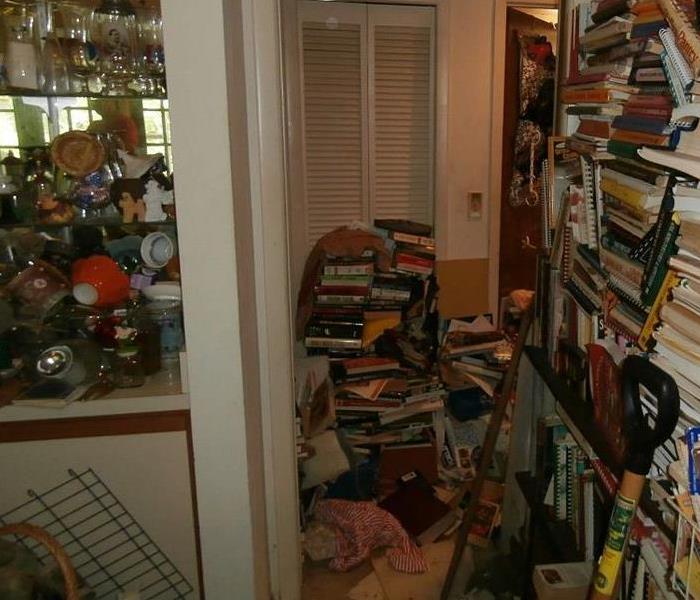 Fire departments are experiencing serious fires, injuries, and deaths as the result of compulsive hoarding behavior.
Fire departments are experiencing serious fires, injuries, and deaths as the result of compulsive hoarding behavior.
Hoarding is a condition where a person has difficulty discarding personal possessions. The large amount of possessions can fill the home and limit the use of space. The excessive accumulation of materials in these homes poses a significant threat to firefighters in the event of a fire and/or responding to other emergencies within these homes. Studies suggest that between three and five percent of the population are compulsive hoarders. Fire departments have had to become familiar with hoarding issues and how to effectively handle emergencies in these homes.
- Hoarding can be a fire hazard and many times occupants die in fires of these homes.
- Blocked exits prevent escape from these homes.
- Many people who are hoarding are injured when they trip over things and/or those personal possessions fall on them. The weight of those personal possessions, especially if water is added to put out a fire, can lead to building collapse.
- Responding firefighters can be put at risk due to obstructed exits.
- Hoarding makes fighting fires and searching for occupants far more difficult.
- Those living adjacent to the occupied structure can be quickly affected when a fire occurs, due to excessive smoke and fire conditions.
If you or a loved one suffers from compulsive hoarding behavior do not hesitate to call SERVPRO Greeley/Windsor at 970-353-1388, we can help with the cleanup. We are available 24/7, 365 days a year.
Ozone VS Hydroxyl
3/5/2020 (Permalink)
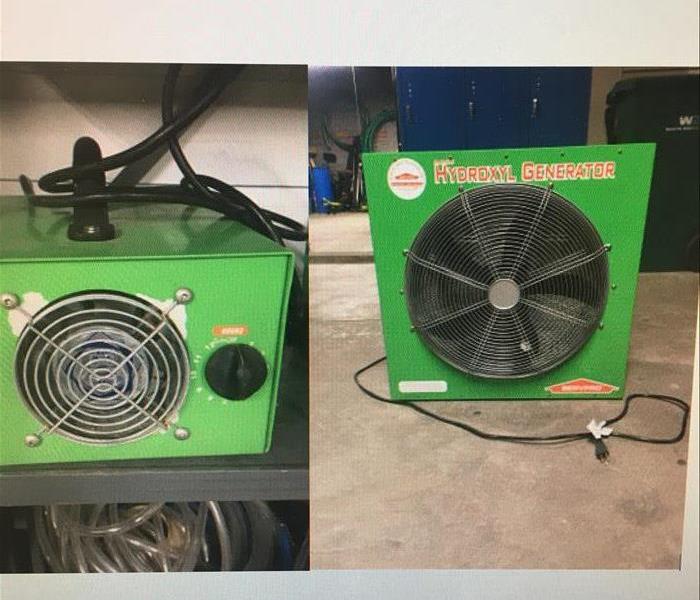 Ozone or Hydroxyl, Which is Your Choice
Ozone or Hydroxyl, Which is Your Choice
A common theme between ozone and hydroxyl is "ozone is more effective and efficient, and hydroxyl is effective but takes longer." The advantages of hydroxyls are: 1) No strong odor, 2) works in high humidity, and 3) the unit can be run while people are still in the building. Because "time is money" and ozone equipment will do the job more quickly, we find the majority of odor issues are most often done with ozone machines.
The difference may lie in the fact that ozone does "reach out and touch" every part of the room. The 20-minute lifespan of ozone allows it to stay in place and oxidize odors and contaminants for a longer period, whereas, hydroxyls do not last that long. The goal of the hydroxyl unit is to use massive air flow to treat as much air as possible with the expectation that the constant introduction of hydroxyls will match ozone's reach. The inconvenience of ozone is the need to vacate the treated areas and a lingering ozone smell that dissipates in about 24 hours, although you should always air-out the room after the treatment allowing the ability of people to return to the building.
Whether you choose ozone or hydroxyl you will notice a difference in your home, but to what degree and for how long depends on each person, as odor sensitivity is subjective to each person.
If you experience fire/smoke damage, call SERVPRO of Greeley/Windsor, 970-353-1388.
Highly Trained Restoration Specialists
Our SERVPRO Professionals are highly trained in property restoration. From initial and ongoing training at SERVPRO's Corporate Training Facility to regular IICRC industry certifications, our Professionals are equipped with the knowledge to restore your property. The SERVPRO training program includes, but not limited to, the following:
- IICRC Training
- Employee Certification Training
- Initial Franchise Training
- e-Learnings
- Continuing Education Classes
Extension Cord, Safety Tips
2/4/2020 (Permalink)
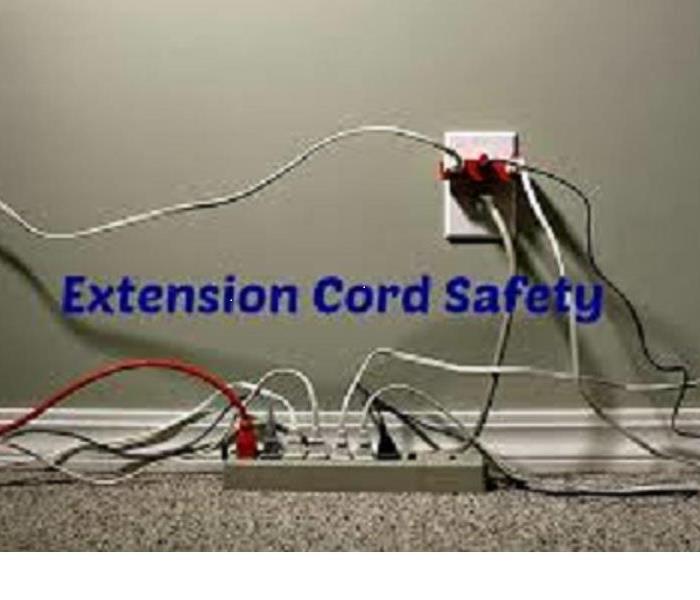 Reaching to Safety: Use Extension Cords Properly
Reaching to Safety: Use Extension Cords Properly
Extension cords are one of the most commonly misused items in a home and at the office. To ensure safety use these following tips when using extension cords to avoid fire damage:
- Determine the correct wattage required to power the device and be sure to select the correct size of the extension cord. If connecting two or more devices, add together the wattage rating for all devices to prevent overload.
- Select the appropriate extension cord for using devices indoors or outdoors.
- Do not use extension cords that are cut or damaged. Touching the exposed strand of wire can give someone electric shock or burn.
- Be sure to unplug extension cords when finished using due to the cord will still conduct electricity until it is unplugged.
- Running a cord under carpet or across a doorway is unsafe.
SERVPRO of Greeley/Windsor specializes in the cleanup and restoration of residential and commercial property after a fire, smoke or water damage event. Our staff are highly trained in property damage restoration. From initial and ongoing training at SERVPRO corporate training facility to regular IICRC-industry certification, rest assured our staff is equipped with the knowledge to restore your property.
If you have experience fire damage call SERVPRO of Greeley/Windsor, 970-353-1388.
.
Preventative Furnace Cleaning
2/3/2020 (Permalink)
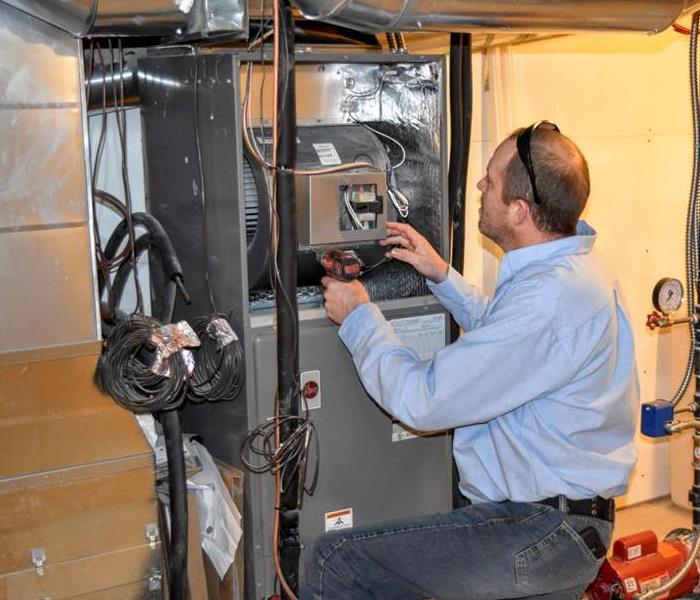 Preventative furnace cleaning helps avoid a fire.
Preventative furnace cleaning helps avoid a fire.
Preventative cleaning on your home furnace is important to ensure it functions correctly and doesn’t cause fire damage. While many people suggest hiring a maintenance professional to inspect annually, there are some things you can do yourself as well to ensure you system runs efficiently.
Replace Filters Regularly
Dirt can be a big problem for heating and cooling systems, by lowering efficiency and burning extra fuel. Keep the system clean by vacuuming around the unit regularly and changing the filter monthly or whatever time frame is recommended by the manufacturer. Leaving old filters to sit for too long will add stress to the compressor and can eventually result in mechanical failures. Not only that, the dirt and debris will get recirculated through your home which can cause allergies and disease. It’s also important to do additional fire cleaning on heaters, radiators, and warm-air registers, while also ensuring they’re not blocked.
Maintenance Before Cold Weather
Many homeowners call a professional to do a yearly inspection and cleaning on their furnace before the heating season to confirm the system is clean and performing in the most efficient way possible. Here are a few steps you can take yourself to keep your bills low while staying warm:
- Calibrate the thermostat. The correct calibration can be lost from excess dirt or being moved around. A furnace maintenance professional can check this annually, or you can replace it with a computerized one.
- Clean and adjust the burners to improve efficiency, and check for any rust accumulation. Reverse ceiling fans to a clockwise rotation to help push warm air down, especially if you have tall ceilings.
- Seal any air leaks and all air ducts, especially in the attic or crawl spaces. Metal tape and insulation can temporarily save an aging duct system.
It’s good to get into the habit of allowing a professional to service your furnace once per year. Waiting until the end of the heating season (the off-season) may give you faster service at a slight discount.
If you have endured some home damage due to a furnace issue, smoke cleaning and remediation services are available that can usually clean up the mess to almost as good as new, call SERVPRO of Greeley/Windsor, 970-353-1388. We answer our phones 24/7/365.
Six Things to Do Immediately After A Fire
1/28/2020 (Permalink)
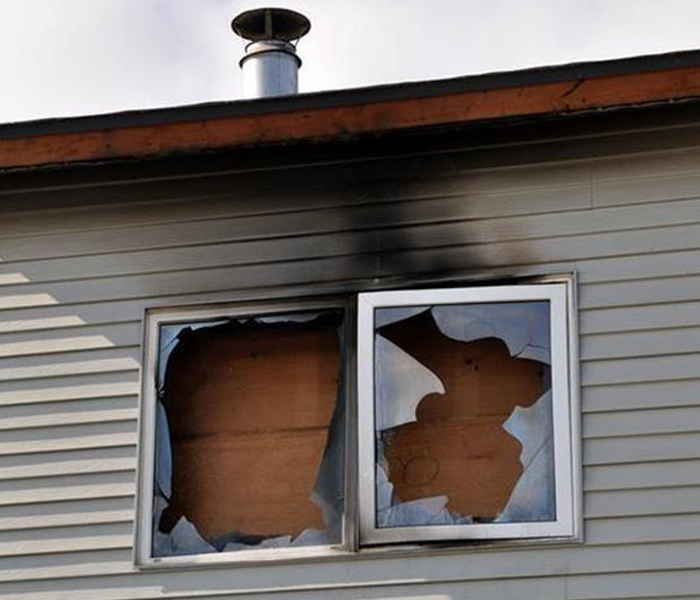 Boarding up damaged windows after a fire damage in Greeley, CO.
Boarding up damaged windows after a fire damage in Greeley, CO.
House fires don’t only happen to Greeley, CO homeowners. If you find yourself dealing with a residential fire, you probably want to start fire restoration as soon as possible.
Six Things You Should Do Immediately After a House Fire
- Find a Place to Stay Staying safe after a fire must be your primary concern. If your house has sustained fire damage, look for a long-term solution. Remember, you must find housing that accommodates you, your family and your pets.
- Board-Up Damaged Windows and Doors Your post-fire home may not be weather tight. It may also attract criminals. To protect your home until you can begin fire restoration, board up damaged windows and doors.
- Contact Your Insurance Company Your insurance adjuster will probably want to inspect fire damage as soon as possible. Once you and your family members are safe, contact a representative of your insurance company.
- Work with Law Enforcement Police investigators and/or firefighters will likely prepare an incident report. This report identifies the cause of your house fire. It is also essential for collecting insurance payments.
- Prepare a Damage List For both insurance and remediation purposes, you need a list of damaged property. Hopefully, before a fire, you created a list of your personal belongings that
- Contact a Restoration Service Even if your house fire is minor, you may have extensive smoke damage. By working with a reputable restoration service for smoke cleaning and fire/water mitigation, you are putting specialized skill and equipment to work for you.
House fires can be devastating. Fortunately, you don’t have to leave your home’s recovery to chance. By taking a few critical steps in the days following a fire, you increase your odds of having a successful fire restoration.
How To Use Fire Extinguishers
10/29/2019 (Permalink)
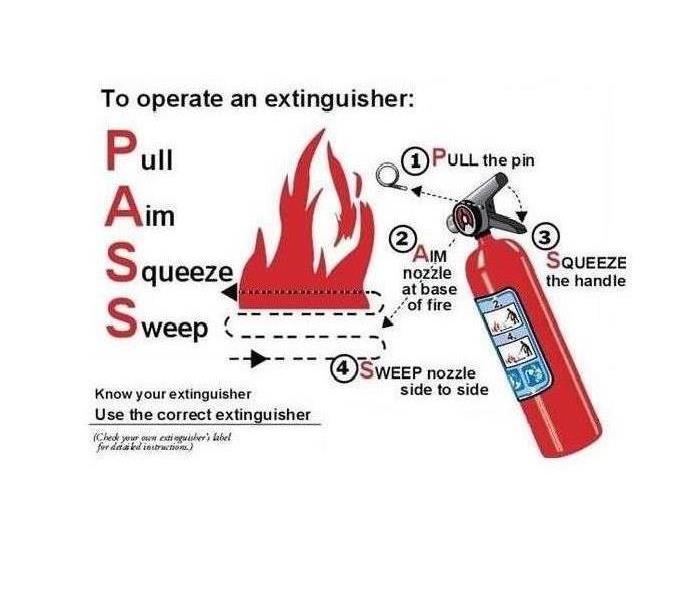 If you are not in danger and feel that you can safely attempt to extinguish the fire, remember the acronym PASS to help you activate the extinguisher.
If you are not in danger and feel that you can safely attempt to extinguish the fire, remember the acronym PASS to help you activate the extinguisher.
SERVPRO of Greeley/Windsor would like to provide you with some valuable knowledge in the event of a small fire. If you are not in danger and feel that you can safely attempt to extinguish the fire, remember the acronym PASS to help you activate the extinguisher successfully.
- Pull the pin at the top of the extinguisher that prevents the handle from being pressed.
- Aim the nozzle at the base of the fire.
- Squeeze the handle to release the extinguishing agent.
- Sweep foam from side to side at the base of the fire.
Watch for re-ignition and repeat the steps if necessary.
It is a good idea to have fire extinguishers conveniently located on each floor of your home or business, as well as areas a fire may break out. Kitchens, Laundry rooms and mechanical rooms are common locations. As always remember safety first and if a fire is too large it is always best to leave the area and call 911 immediately.
Locally Owned Company with National Resources
As a locally owned and operated business, SERVPRO of Greeley/Windsor is strategically located to respond quickly to your fire and water emergency event. When fire damage occurs in Greeley, Windsor, Eaton, Johnstown, Milliken, LaSalle or Evans, we have the resources and personnel to help. Call us today, 970-353-1388.
DO You Have Fire/Smoke Alarms In Your Home?
5/3/2019 (Permalink)
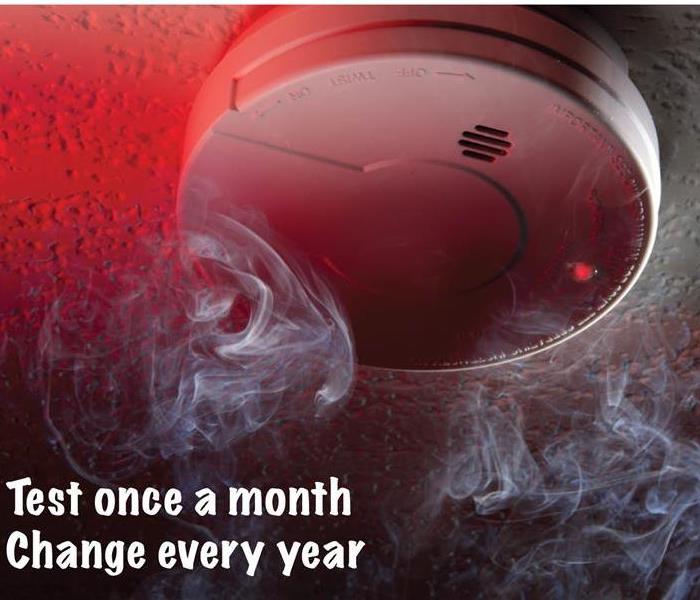 Smoke Alarms Saves Lives
Smoke Alarms Saves Lives
The quantity of smoke/fire alarms required in a home depends on the size and layout of your home. You can ask your friends and neighbors for an opinion, but the answers will all be different; however, the National Fire Protective Association recommends fire alarm placement:
- In every bedroom
- Outside the sleeping areas on all bedroom levels
- On all levels of the home including the basement
- At the bottom of stairways, including the basement stairs
Ionization smoke alarms are best at detecting hot, fast-moving fires. Photoelectric smoke alarms are best at detecting slow-burning smoky fires. If both are available, get some of each and take advantage of both technologies. If a fire alarm with both sensors is available in your area install those throughout your home.
Should My Smoke Detectors Be Connected? Connecting smoke detectors is always a good idea. If there is a fire in your home, you want to know about it right away. Early notification of a fire minimizes fire and smoke damage. You don’t want to wait until a closer detector senses the problem and sounds an alarm.
How Long Does a Smoke Alarm Last? Every smoke alarm has the manufacture date stamped on the back. When ten years from that date has passed, you should replace that unit. If the manufacturer suggests a shorter replacement interval, follow those instructions.
When Should I Replace the Batteries? It’s always good to replace batteries on a regular schedule. A good timeframe is when the time changes in our area, like Daylight Savings Time. However, if you are the type of person that only responds to the low-battery beep, change all of your alarms in your home immediately.
A fire alarm is an essential safety device in your home. It has a long service life, requires little attention and saves lives. It can keep your family safe and minimizes fire damage in your home. Take comfort in the fact that, if you do have a fire, SERVPRO of Greeley/Windsor is the fire remediation experts in our area. We have been trained to bring your lives and your home back to normal quickly.
Practice Safety While Grilling
5/3/2019 (Permalink)
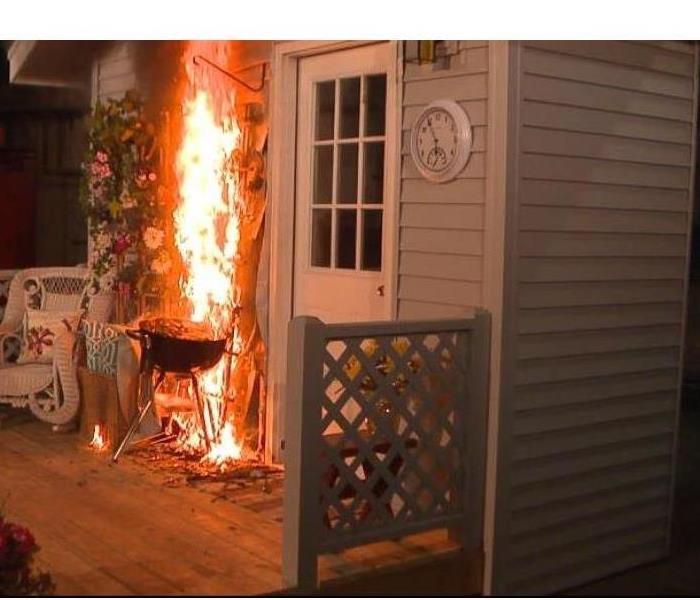 Don't let this happen to your house this grilling season
Don't let this happen to your house this grilling season
Three out of five households own a gas grill, which translates to a lot of tasty meals. But it also means there’s an increased risk of home fires.
Each year an average of 8,800 home fires are caused by grilling, and close to half of all injuries involving grills are due to thermal burns. While nearly half of the people who grill do it year-round, July is the peak month for grill fires followed by May, June and August.
- Grill fires on residential properties result in an estimated 10 deaths, 100 injuries, and $37 million in property loss each year
- Almost half (49%) of grill fires on residential properties occur from 5:00 to 8:00 PM
- Over half (47%) of grill fires on residential properties occur in the four moths of May, June, July, and August.
- Heat from powered equipment is the leading heat source category for grill fires on residential properties (47%). Spark, ember, or flame from operating equipment accounts for 28% of all grill fires on residential properties.
- Leaks or breaks were the factor in 11% of grill structure fires and 23% of outside and unclassified grill fires
- Gas grills contribute to a higher number of home fires overall than their charcoal counterparts
Electric Space Heater Safety Tips
11/20/2018 (Permalink)
It’s winter, we are all turning to heaters to stay warm. They are the ultimate winter must have to keep your house/office nice and toasty. If you are using a space heater do not plug it into an extension cord power strip! Why? Doing so can result in a terrible fire hazard!
According to fire experts, extension cords and power strips are not equippedto handle the extra current flow needed to power a space heater and can overheat, eventually catching on fire. Firefighters state heating elements in a space heater can get up to more than 500 Fahrenheit to 600 Fahrenheit.
If you wish to use a space heater you should only plug it in directly it to the wall and keep an eye on it when it’s in use, meaning, unplug it before you leave the house/office. From 2009 to 2013, heating equipment involved an estimated 56,000 reported U.S. home fires which accounted for 156 percent to the total.
According to the National Fire Protection Association, out of those fires, 470 people died, 1,490 were injured and over $1 million in property damage was reported.
Safety tips for running an electric space heater during cold winter months include:
- Place the heater in a dry location, moisture can potentially damage its components.
- Do not plug other devices into the same outlet as the heater since they tend to draw a lot of power.
- Never run an electric cord underneath a rug or carpet, they could catch on fire and keep at least three feet away from anything that can burn.
- Unplug the heater after turning it off.
- When running your heater, don’t leave the room for a long period of time without turning it off.
- Plug space heaters directly into a wall outlet and place them on a flat surface. Do not use an extension cord or power strip.
SERVPRO hopes that you never have to handle a electrical fire but if you do call SERVPRO of Greeley/Windsor, 970-353-1388, to get a speedy cleanup and get your house looking “Like it never even happened.”
HOLIDAY KITCHEN FIRES
11/19/2018 (Permalink)
As Thanksgiving approaches many of us are getting ready to cook up some of our favorite family recipes. Be sure to take some precautions to make sure that your kitchen doesn't end up in flames!
According to the National Fire Protection Agency Thanksgiving is the top day for home cooking fires (almost 3 times the daily average).
SERVPRO Greeley/Windsor wants to share some tips to help prevent a fire from ruining your Thanksgiving dinner!
- Be Present- Fires are often started when items cooking are left unattended. If you need to leave the kitchen for a period of time, turn off the oven or stove!
- Dress Accordingly- Avoid wearing lose clothing or dangling sleeves while cooking. Lose clothing can easily catch fire if it comes into contact with a gas flame or electric burner.
- Keep Kids Out- Enforce a "kid free zone" of three feet around the perimeter of the stove. If kids are present in the kitchen, use the stove's back burners whenever possible and turn pot handles inward to reduce the risk that pots with hot contents will be knocked over.
- Clean, Clean, Clean- Be sure your stove top and oven are free of grease, which can easily catch fire. Additionally, keep all combustible cooking accessories, such as pot holders, oven mitts and wooden utensils, away from the stove top.A fire extinguisher should always be at hand to quickly extinguish any fires that may occur on the top of the stove. Of course, in the event of an emergency, never hesitate to call 911.
- The best defense against a fire is to prevent them from ever happening! If a fire should ignite in kitchen turn off the oven, unplug the appliance and remove any dish towels that may be hanging on the front of the oven door.
Call SERVPRO of Greeley/Windsor for your emergency mitigation needs at 970-353-1388. We make it “Like it never even happened.”
Highly Trained Restoration Specialists
Our SERVPRO Professionals are highly trained in property restoration. From initial and ongoing training at SERVPRO's Corporate Training Facility to regular IICRC industry certifications, our Professionals are equipped with the knowledge to restore your property. The SERVPRO training program includes, but not limited to, the following:
- IICRC Training
- Employee Certification Training
- Initial Franchise Training
- e-Learnings
- Continuing Education Classes
Fire Evacuation Plan, Do You Have One?
3/29/2018 (Permalink)
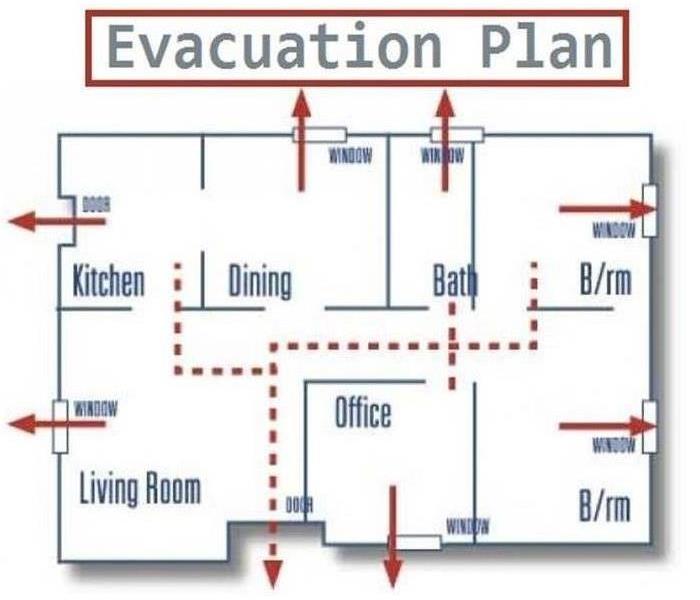 Do you have your Fire Evacuation Plan?
Do you have your Fire Evacuation Plan?
Smoke detectors are VERY important in a home/business safety plan, but do not forget a fire evacuation plan.
When was the last time you and your family or co-workers practiced an evacuation drill? Maybe, it has been awhile. It’s easy to forget about your overall evacuation plan, so it’s a good idea to schedule a drill quarterly to go over a complete Fire Evacuation Plan with your family/co-workers.
- A closed door may slow the spread of smoke, heat and fire. Install smoke alarms in every sleeping room, outside each sleeping area and on every level of the home.
- Everyone in the household must understand the escape plan. When you walk through your plan, check to make sure the escape routes are clear and doors and windows can be opened easily.
- Choose an outside meeting place (i.e. neighbor's house, a light post, mailbox, or stop sign) a safe distance in front of your home or business where everyone can meet after they've escaped. Make sure to mark the location of the meeting place on your escape plan.
- Go outside to see if your street number is clearly visible from the road. If not, paint it on the curb or install house numbers to ensure that responding emergency personnel can find your home.
- Have everyone memorize the emergency phone number of the fire department. That way any member of the household can call from a neighbor's home or a cellular phone once safely outside.
- If there are infants, older adults, or family members with mobility limitations, make sure that someone is assigned to assist them in the fire drill and in the event of an emergency. Assign a backup person too, in case the designee is not home during the emergency.
If you experience fire damage, call the professionals at SERVPRO of Greeley/Windsor, 970-353-1388.
Have You Checked Your Smoke Alarms?
3/26/2018 (Permalink)
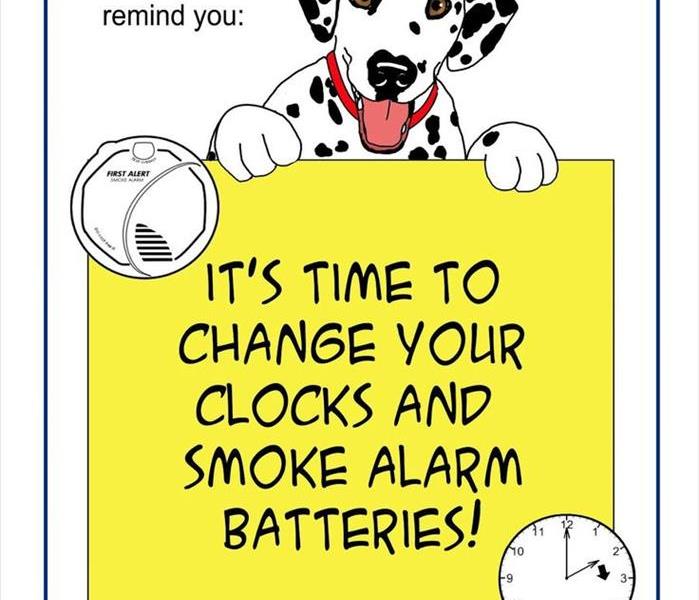
March marks the beginning of daylight saving time and serves as a good reminder for everyone to test their smoke alarms. Our local Fire Department is urging residents to test their smoke alarms before automatically changing the batteries. Smoke alarm technology has advanced and many now come with 10-year batteries and some are tamper-resistant. Ionization-only smoke alarms that are solely battery powered to come equipped with a hush feature and a 10-year battery are highly recommended. Because of this technology, the national slogan "Change your clock, Change your battery" may not apply to property owners who have these ionization-only smoke alarms. Other types of alarms are also being sold with either a 10-year battery or a standard-life battery. So be sure to know what type of smoke alarm you have. Ensuring you have working smoke alarms in your home is the single most important step you can take to increase your family's safety from a home fire. As a reminder it is best to replace any smoke alarm that is 10 years old or older To test your alarm properly we recommend you:
- Push the test button to be sure the battery is working.
- When replacing batteries, follow the manufacturer's instructions for the correct battery type to use.
- Always retest alarms after installing new batteries.
- Replace any alarm that fails to operate after installing a new battery.
- Inspect your alarms to determine if they are 10 years old or older, and replace any smoke alarm 10 years old or older. Look for a date on the back of the alarm. If there is no date, your alarm is more than 10 years old and should be replaced.
- Follow the manufacturer's instructions for regularly cleaning your alarms of dust and cobwebs.
Working smoke alarms provide a critical early warning to a fire, allowing you vital minutes to escape, which increase your chances of survival. Additional safety tips:
- Install smoke alarms on every level of your home, in each bedroom, and outside each sleeping area (hallway).
- Never disconnect or remove batteries from smoke alarms for other uses.
- Use the smoke alarm's hush feature to silence nuisance alarms.
- Make a home fire escape plan and practice it with family members.
- Practice you home fire escape plan at least two times a year at different times of the day/night.
- Children, older adults, and people with disabilities may need assistance to wake up and get out. Ensure that someone will help them.
Highly Trained Restoration Specialists
Our SERVPRO Professionals are highly trained in property restoration. From initial and ongoing training at SERVPRO's Corporate Training Facility to regular IICRC industry certifications, our Professionals are equipped with the knowledge to restore your property. Our SERVPRO training program includes, but not limited to, the following:
- IICRC Training
- Employee Certification Training
- e-Learnings
- Continuing Education Classes
- For your fire mitigation needs, call SERVPRO of Greeley/Windsor, 970-353-1388, we make it “Like it never even happened.”
Fire Damaged Caused By Space Heaters
3/12/2018 (Permalink)
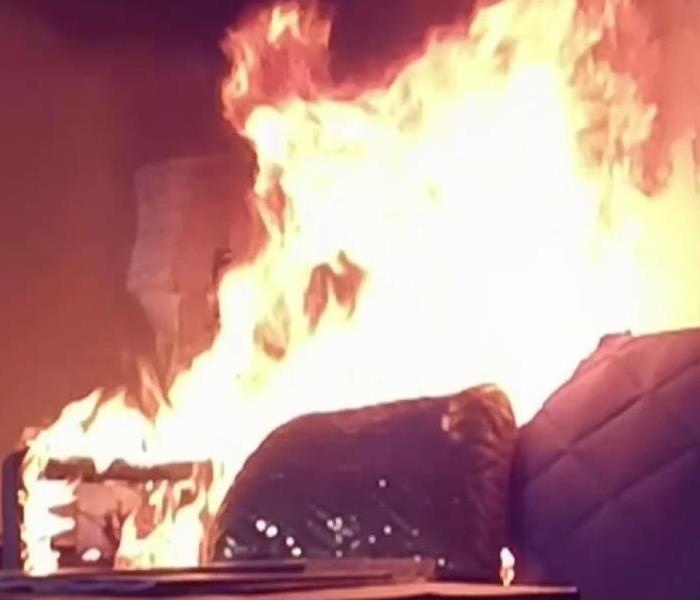 Precautions are necessary when using space heaters in your home.
Precautions are necessary when using space heaters in your home.
To stay warm indoors, many homes invest in space heaters. But did you know that space heaters, if not properly used, are the leading cause of residential and commercial fires?
Space heater caused fires can occur without the proper safety precautions. The devastating results of fire damage can make a family homeless and close down a commercial establishment. However, when used correctly, space heaters can be safe to use. SERVPRO of Greeley/Windsor safety features and tips to stay safe in using electric space heaters are:
Space heater should be placed on a flat, solid exterior
- Always plug the space heater directly into a wall socket
- Use a heater with an automatic shut-off feature.
- Use a three-foot space zone around space heaters.
- Supervise children and pets around space heaters that are on.
- Never leave a space heater on when absent or asleep.
Space heaters help to give warmth during cold, chilly days. Make sure you practice safety and keep an eye on your space heater, don't leave it attended. As comfortable as they are to use in the winter, they can easily destroy a home or an office building.
SERVPRO of Greeley / Windsor is a trusted leader in the restoration industry, and our highly trained technicians provide 24-hour emergency service. We’re dedicated to responding faster to any size disaster with the training, equipment, and experience to respond to your restoration or cleaning needs.
Respecting Your Outlets Can Prevent Fire Damage to Your Home
12/7/2017 (Permalink)
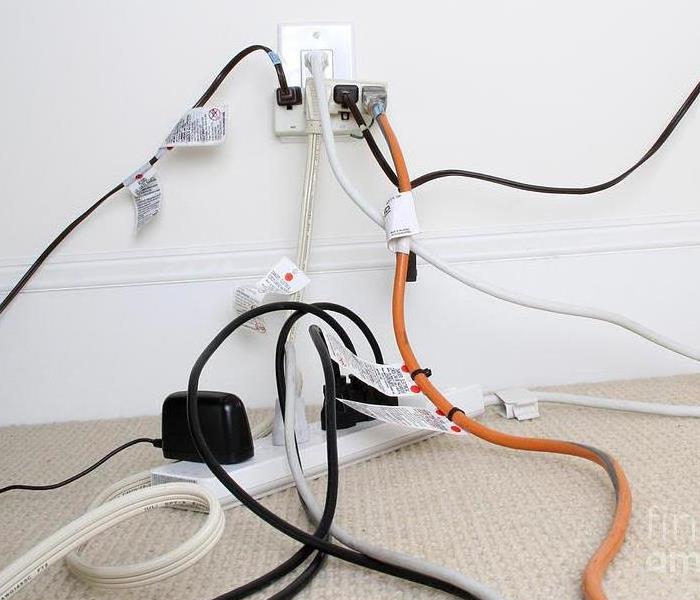 Overloading outlets can result in a fire in your home.
Overloading outlets can result in a fire in your home.
Fires happen all the time. When you are the one the fire is happening to, you want to figure out its cause and how to get back to the way things were before. Understanding some of the most common causes of small house fires is an excellent start to keeping yourself safer throughout the year. Overloaded power outlets provide a perfect storm for sparks or electrical arcs to catch nearby materials on fire. Stressed outlets are a primary cause of many household fires.
When your home is damaged from a fire, you need to find out why it happened. Our SERVPRO team can help you to clean up the mess and restore the damage, but also has the experience to help you determine where the fire originated from based on the severity of the damages. As common as overloaded electrical boxes are, it remains one of the leading causes of accidental house fires. You need to know how to operate your power outlets within safe parameters. This information can potentially save your house from damages, but more importantly, save your life.
People ask too much of their power outlets all the time, but this gets even worse around the holidays. When you combine indoor and outdoor lights, the tree, and other decorations in with already stressed power sources, you are brewing a recipe for disaster. To make matters worse, the spark of a fire can occur from this overloaded outlet at any time.
The sooner you respond to restoring your home after fire damages the better. Our experienced SERVPRO professionals can clean up the damages and bring the structure and contents of the room back to preloss conditions. The longer that you wait, the more likely that soot and smoke damages seat themselves into your furniture, flooring, and walls. This spells a higher insurance claim to cover the repair costs, or worse yet, more out-of-pocket expenses if you are underinsured.
If you or someone you know experiences a fire, call as soon as you can. Our professionals at SERVPRO of Greeley/Windsor rapidly respond 24/7, and you can reach us at (970) 353-1388.
Behavior of Smoke
12/6/2017 (Permalink)
The damage to your property following a fire can often be complicated due to the unique behavior of SMOKE.
There are two different types of smoke:
Wet
Dry
As a result, there are different types of soot residue after a fire.
Wet Smoke (Plastic and Rubber)
- Low heat
- Smoldering
- Pungent odor
- Sticky
- Smeary
NOTE: Smoke webs are more difficult to clean.
Dry Smoke (Paper and Wood)
- Fast-burning
- High temperatures
- Heat rises, therefore smoke rises.
Protein Fire Residue (Produced by evaporation of material rather than from a fire)
- Virtually invisible
- Discolors paints and varnishes
- Extreme pungent odor.
Fuel Oil Soot (Furnace Puff Backs)
- While “puff backs” can create havoc for homeowners, SERVPRO® Franchise Professionals can, in most cases, restore the contents and structure quickly.
Other Types (Tear gas, fingerprint powder, and fire extinguisher residue)
- These special loss situations require special care.
Additional facts you may not know about smoke:
- Hot smoke migrates to cooler areas and upper levels of a structure; and
- Smoke flows around plumbing systems, seeping through the holes used by pipes to go from floor to floor
The type of smoke may greatly affect the restoration process.
SERVPRO® Franchise Professionals are trained to handle even the toughest losses. If your home or business suffers fire or smoke damage, contact SERVPRO® of Greeley/Windsor to make it “Like it never even happened.”
Residential Fire Damage - Don't Wait
11/3/2017 (Permalink)
Apart from causing physical harm, fire accidents also lead to damage to your property. Smoke and soot are the major culprits when it comes to property damage. So, what happens when you experience fire damage in your home - do you buy a new home, or do you move out? Well, all these are costly alternatives, but unnecessary. All you need is to have fire damage restoration to make your home as good as new.
What Happens After a Fire Accident?
During fire, a lot of smoke and soot is produced. This is due to the items in your house that burn up. As smoke and soot linger in the air it is deposited on various surfaces in the home. Walls, carpets, appliances, and ceilings begin yellowing, which spoils them. The fire also leaves odor on these items. With prolonged exposure to these elements, it becomes harder to remove them.
Handling the aftermath of fire damage might seem a simple task to you, but it is involving and needs you to hire a professional for quick and efficient restoration.
What Does Fire Damage Restoration Involve?
The focus of the expert is to take your home back to its original state before the fire incident. The specialist undertakes the restoration in a series of steps guaranteed to leave your home free from any smoke damage or soot. Here are the steps:
Post-damage Inspection
The specialist inspects the structure to determine the extent of damage. Your premises are checked for smoke damage and any structural damage. The aim of inspection is to understand the extent of the damage and determine the proper cleaning method.
Protecting Unaffected Areas
Not all items in your home are affected by the fire. There are those that were not touched by the fire or were partially damaged and have to be secured. Before the procedure, the specialist separates the items that can be salvaged and covers them to prevent further losses. Protecting the items prevents any unnecessary expenses.
The Restoration Process
It is up to the specialist to determine the type of restoration to use in your home. The specialist then removes any damaged materials and debris that resulted from the fire. After removal, extensively damaged structural elements are replaced.
During the fire incident, firefighters use a lot of water to put out the fire. The specialist performs water extraction to remove any excess moisture that resulted from putting out the fire. After this, the specialist removes soot, deodorization, and ash. The process culminates in a new paint job.
Final Words
The longer you wait after fire damage, the more costly it becomes for you. You need to use professionals for the process so that you get the best results.
Call the fire mitigations specialists at SERVPRO of Greeley/Windsor, 970-353-1388.
Fire and Smoke Damage
5/20/2016 (Permalink)
Water damage
You will need to dry wet items as soon as possible. Your professional will bring large industrial fans and dehumidifiers to dry your carpets and window treatments. If not thoroughly dried, carpets and floors underneath may be quickly damaged beyond repair by mold and mildew. This is an important step. Otherwise they may have to be replaced. If walls and ceilings have water damage, they will need to be repaired or fully replaced. Soot will need to be removed to inspect damage as well.Soot removal
Soot is oily and easily stains carpets, draperies and other items in your home. For this reason you must remove the soot before you attempt to clean or deodorize items. Your professional will remove window coverings and furniture and work on removing soot with a heavy-duty vacuum. In some cases, your textiles may just be ruined and need to be replaced, so ask if they are worth cleaning before you spend the money to do so. Based on the type of paint and finish you have on your walls and ceiling, your professional will have to use a mixture of chemicals to remove the soot damage.Furniture and textile deodorizing
Smoke odor may remain in clothing, upholstered furniture, carpets, and draperies unless they are properly deodorized before cleaning. Consult professional fire restorers or dry cleaners about using a counteractant, a chemical or additive that breaks up smoke molecules to eliminate odors. The type used will vary with the type of material burned in the fire. Restorers also may provide them for laundering clothes for an additional fee. Fire restorers and dry cleaners sometimes use an ozone treatment to break up smoke molecules and eliminate odors. If the process is done in the home, items are put under a tent while an ozone generator is operating. Keep in mind that most household deodorizing sprays and disinfectants provide only temporary relief. In addition, deodorizing sprays may interact with smoke odor and create an additional odor.Walls, surfaces and ducts
During a fire, smoke can permeate walls and drift through household ducts, where it becomes trapped. If not properly removed, smoke odor will rise up again from time to time, especially during warm or damp weather. Consult professional restorers about a process known as thermal fogging. This warm chemical fog penetrates your home and walls just as the fire did, neutralizing the smoke odor as it goes. Also consult restorers about removing smoke from your ducts. They may use a chemical sealer to secure smoke permanently to the sides of your ducts since these areas, with their joints and crevices, may be difficult to clean with conventional vacuum-and-brush methods. You might also consider replacing the insulation in your attic, since insulation retains smoke during a fire and can cause the smell to move through your home during warm weather.



 24/7 Emergency Service
24/7 Emergency Service

























